
What Is A Catamaran Sailboat? (And What It Looks Like)

Last Updated by
Daniel Wade
August 30, 2022
Catamarans are increasingly popular for sailing and commercial use, but what sets them apart from monohulls and other multihulls?
A catamaran is a twin-hull boat with two equally-sized hulls placed side by side. They’re powered by engines, sails, or both—and they’re known for efficiency and speed. Catamarans are the most common kind of multihull boat.
In this article, we’ll go over the characteristics of catamarans and how to differentiate them from other types of boats. Additionally, we’ll cover the advantages and disadvantages of catamarans and compare them to trimarans and monohulls. We’ll also go over the most common types of catamarans and their uses.
We sourced the information in this article from marine design guides, boat identification resources, and the online boating community.
Table of contents

How to Spot a Catamaran
Spotting a catamaran is easy. Simply look at the hulls and count them. Catamarans have two hulls side by side and a relatively large gap between them where you can see light on the other end. Catamarans are distinct from trimarans, which have an additional hull between the two outer hulls.
How do Catamarans Work?
The principle behind the catamaran is simple. You can think of catamarans like cars and monohulls like motorcycles. Catamarans distribute their weight between hulls on either side, whereas monohulls utilize only one hull.
Evidently, cars are much more difficult to tip over and can hold much more weight. Additionally, cars are wider, as they have much more contact with the road. Catamarans work in a similar way, as they have a wide stance and contact with the surface on both sides.
Obviously, that isn’t the most precise comparison. But the basic principle is the same, and catamarans have a few notable benefits over monohulls.
Catamaran Vs Monohull
Catamarans are easy to distinguish from monohulls. A monohull is just a regular old boat with a single hull. The vast majority of boats and ships are monohulls. Catamarans have two hulls, which are usually sleek and narrow.
Here are some comparisons of catamarans and monohulls, along with the advantages twin-hull designs have over most single hull types.
Benefits of Catamarans
Catamarans have numerous benefits. The first is speed. Catamarans produce less drag than monohulls and thus can achieve excessive speeds both under sail and power. They don’t need to plane like monohulls to achieve these high speeds, and they use less fuel.
Catamarans are also much more stable than monohulls. They have a wide stance and shallow draft, and many waves and swells can travel between the hulls instead of below them. This effectively reduces an entire axis of movement and prevents catamarans from rolling excessively.
Drawbacks of Catamarans
Catamarans aren’t advantageous in every way, or else we wouldn’t bother building monohulls. The disadvantages of catamarans limit their use to niche commercial applications and high-end yachts. But what are the drawbacks of a twin-hull design?
Sailing catamarans don’t follow many of the traditional boat handling rules and characteristics that sailors pass down for generations. Some, such as hull speed limitations, are good to do away with—while others, such as responsiveness, are not.
Catamarans aren’t as quick to the helm or responsive as monohulls. There are some exceptions to this rule, but for the most part, you’ll get a lot more feedback from a single-hull vessel. Additionally, the large section of deck between the hulls of a catamaran is prone to pounding in rough seas, which is loud and uncomfortable.
Catamarans can sometimes be twice the width of an equivalent monohull sailboat, which can increase mooring fees and limit docking options.
The final major drawback of catamarans is a consequence of their stability. Traditional full-keel monohull sailboats have a very low center of gravity, which makes them roll in heavy seas but ensures a recovery.
Catamarans have a higher center of gravity, and they can’t right themselves after a knockdown. And though catamarans are less likely to roll, a severe list on a multihull is a much more serious concern than on a ballasted monohull.
Catamaran Vs Trimaran
Catamarans and trimarans are often lumped together, but they have very different design and performance specifications. Trimarans have three hulls, whereas catamarans have two.
Trimarans look a lot like catamarans from the side, but a quick glance at the bow or stern can set them apart. Trimarans are faster than catamarans, as they distribute their weight across three hulls instead of two. This helps them stay centered and reduces interference from pitching and rolling.
Catamarans are fast, but they lose out to trimarans when going head to head. However, catamarans are much less expensive to build and maintain and often have roomier cabins due to their larger hulls.
Types of Catamarans
There are numerous types of catamarans, and their uses vary widely. The catamaran is one of the oldest and most useful hull types, and some variants have been used for thousands of years. Here are the most common kinds of catamaran boats and their uses.
Sailing Catamaran
Sailing catamarans are probably what you think of when you hear the name. Sailing catamarans are sailboats with two identical hulls connected by a center deck. The largest sailing catamarans are spacious and stable vessels that are capable of serious offshore sailing.
Sailing catamarans have a number of notable advantages over monohulls. Monohulls, which are traditional sailboats with a single hull, are limited by a simple concept called hull speed. As the bow and stern wave of a monohull intersect, they cause drag which limits the top speed of the boat.
Catamarans are not bound by hull speed limitations, as they have two hulls. Catamarans can go twice or even three times as fast as similar monohulls and achieve excellent travel times.
Catamarans are also more stable than monohulls, as their wide stance and shallow draft reduce the effect of rough water. They don’t heel, as the force of the wind is counteracted by the double hulls. Additionally, modern sailing catamarans can ‘wave pierce’ by cutting through swells instead of riding over them.
Sailing catamarans come in many shapes and sizes. Small sailing catamarans, such as those used in races and regattas, are known for their speed and relative stability compared to light racing monohulls. Sometimes, they feature a smaller second hull for stability—these are called outriggers.
Sailing catamarans have spacious interiors thanks to the large cockpit between the hulls. This cockpit usually contains cooking and eating spaces, a place to sit, and a hallway between the hulls. The hulls usually contain living quarters and often mirror each other.
Power Catamarans
Power catamarans have an even greater variety than sailing catamarans. These vessels are used for everything from party platforms to ferries and patrol boats.
Power catamarans are a recent development, as engineers and marine architects now realize they have numerous hydrodynamic advantages over other hull types.
Catamarans are much more efficient than other hull types, as they have less drag relative to their size. Additionally, you can build a much larger catamaran with less material. This makes them popular for car and rail ferries, as builders can construct a very wide vessel with two small hulls rather than a narrower vessel with a large single hull.
Military and Commercial Catamarans
Even the military has found a use for the catamaran hull shape. The Spearhead class EPF is an expeditionary fast transport vessel designed for carrying capacity and speed. It has two sharp hulls and a huge cargo capacity.
The Spearhead class EPF is 337 feet long, which is about the same length as a WW2 escort destroyer. Yet despite having a similar length and displacement, these catamarans can travel more than twice as fast—43 knots, or nearly 50 miles per hour. Their great speed is a direct consequence of their catamaran hull type.
Power catamarans are also used as patrol and utility boats on a much smaller scale, with either outboard or inboard motors. The State of Texas uses catamarans to patrol shallow rivers and lakes. Texas Game Wardens utilize state-of-the-art aluminum catamaran patrol boats, which are fast enough to outrun most fishing boats.
There’s another form of power catamaran that you may not have considered. Pontoon boats are technically catamarans, and they’re enormously popular on lakes and rivers throughout the country. Pontoon boats aren’t known for speed, but they’re a great platform for a fun and comfortable outing.
Catamaran Houseboats
The final common type of power catamaran is the two-hulled houseboat. Houseboats don’t always use the catamaran hull type, but it’s common enough that most major manufacturers offer it as an option.
Catamaran houseboats have a few notable advantages over monohull designs. For one, they’re easier to build—especially when pontoons are chosen. Additionally, they’re better suited for navigating shallow water. These vessels can support more weight across their two hulls, offer increased stability, and they’re also efficient.
Why Aren’t Catamarans More Common?
With all the advantages listed in this article to consider, it may seem strange that the use of catamarans is still somewhat limited. At the end of the day, it comes down to economics—as monohull boats and ships are simply cheaper to build.
Additionally, catamarans have some distinct limitations. Monohulls have lots of storage space in their hulls and can carry thousands of tons of cargo safely in all weather conditions. Catamarans lack this space and low center of gravity, so they’re not ideal for transporting cargo past a certain point.
Additionally, monohulls work, and many people are reluctant to experiment with new designs when old designs work just fine. This rule applies to both large and small boats.
A large monohull sailboat can be constructed at low cost from stock plans and reliably sail almost anywhere. Very little complex structural engineering is involved, and looser tolerances reduce cost and maintenance requirements.
Related Articles
I've personally had thousands of questions about sailing and sailboats over the years. As I learn and experience sailing, and the community, I share the answers that work and make sense to me, here on Life of Sailing.
by this author
Learn About Sailboats
Most Recent

What Does "Sailing By The Lee" Mean?
October 3, 2023

The Best Sailing Schools And Programs: Reviews & Ratings
September 26, 2023
Important Legal Info
Lifeofsailing.com is a participant in the Amazon Services LLC Associates Program, an affiliate advertising program designed to provide a means for sites to earn advertising fees by advertising and linking to Amazon. This site also participates in other affiliate programs and is compensated for referring traffic and business to these companies.
Similar Posts

Affordable Sailboats You Can Build at Home
September 13, 2023

Best Small Sailboat Ornaments
September 12, 2023

Discover the Magic of Hydrofoil Sailboats
December 11, 2023
Popular Posts

Best Liveaboard Catamaran Sailboats
December 28, 2023

Can a Novice Sail Around the World?
Elizabeth O'Malley
June 15, 2022

4 Best Electric Outboard Motors

How Long Did It Take The Vikings To Sail To England?

10 Best Sailboat Brands (And Why)
December 20, 2023

7 Best Places To Liveaboard A Sailboat
Get the best sailing content.
Top Rated Posts
Lifeofsailing.com is a participant in the Amazon Services LLC Associates Program, an affiliate advertising program designed to provide a means for sites to earn advertising fees by advertising and linking to Amazon. This site also participates in other affiliate programs and is compensated for referring traffic and business to these companies. (866) 342-SAIL
© 2024 Life of Sailing Email: [email protected] Address: 11816 Inwood Rd #3024 Dallas, TX 75244 Disclaimer Privacy Policy

A Trusted Source For Boating Information Since 2019
A complete catamaran guide.
- Post Written By: Boater Jer
- Published: January 26, 2020
- Updated: November 27, 2020

Disclaimer: You might notice that we recommend products in some articles. We may earn a commission for referring you if you click the link and buy a product.
We only recommend products we’ve tried/tested/own (that’s why you won’t find thousands of affiliate links on my site). If you have experience with one of the products we’ve mentioned, please share your experiences in the comments at the end.
Advertisement

There you are, out on the water when a strange craft approaches. Is it a sailboat? It sure looks like one until it turns to face you. That’s when you notice this boat doesn’t have just one hull. It has two hulls and it’s called a catamaran.
Catamarans are unique, and highly stable watercraft. We’ll explore all the ins and outs of sailing the waters in one of these weird, and awesome multi-hulled craft. Join me as we explore the wild world of sailing catamarans.
A History Of The Catamaran
It is believed that the first people to use a catamaran design were those living in Australasia.
The succession of boat design in this region was actually very interesting. The beginning of boats in the area was simple, albeit conventional rafts. These were fashioned from logs strewn together with plant fiber lashings such as those formed using bamboo fiber.
Catamaran Evolution
The conventional raft gave way to a minimal raft. This design was basically a conventional raft with two cross beams added in the form of logs. These would be eventually hollowed out to improve buoyancy.

The next step in the evolution of boats in the Australasian region was the double canoe. This proved to be the first real catamarans.
After some time, the form evolved further into the asymmetrical double canoe design. In this design, one canoe was large and the other attached canoe was smaller.
The asymmetrical design quickly evolved into the single-outrigger boat like the one shown in the photo below.
The final stage of the evolution of the catamaran in the region was to gain a second outrigger. This in effect created the trimaran with the single central hull and dual outriggers.
Eye Witness Accounts Of Catamarans
In 1697, William Dampier wrote of witnessing a type of seafaring vessel off the coast of Coromandel. He noted how the locals called the type of boat a catamaran. He also noted that it had multiple hulls (logs) and that they were small vessels that the person operating would have to hang partway into the water, straddling the hull (log).
The name catamaran came from the Tamil. And yet, it was easily applied by the European visitors to the two hulled sailing vessels that sped across the water in the region.
Although Dampier may have described the catamaran in the 1690s, the type of boat was actually used as early as the 5th century by the Tamil Chola dynasty. They used boats to move their troops from one island to another. Using this design of boat allowed them to travel heavy, travel quickly and was partially responsible for the conquering of neighboring Burma, Malaysia, and Indonesia.

Building A Boat – Basics Of Catamaran Construction
A boat is usually thought of as being a single-hulled vessel that travels along the surface of the water. It can have multiple types, shapes, and designs of the hull. However, it is often only thought of as having a single hull. But, what if it had two hulls? Would that be like taking two separate boats, and making a raft over both of them? In essence, that is exactly what a catamaran is: two boats made into one.
Advantages Of Multiple Hulls
- More stability than a monohull
- Wide supporting base allows for larger sails than monohull craft of the same length
- Hull does not require the deep-running keel of a standard monohull sailboat
- Less hull drag in the water than a monohull
- Less power required to drive a catamaran forward than a monohull boat
Disadvantages Of Multiple Hulls
- Due to multiple hulls, construction is more expensive than a monohull design
- Catamaran speed relies on lightweight materials to make a lightweight craft. This also drives up the cost of construction.
- Extra engineering requirements for multi-hull craft also increase the cost of construction.
Conclusion? Well, it looks to me like everything about catamarans points towards superiority over monohulls in nearly every way. But, you get what you pay for. I think the same thing likely applies to cars too. For instance, I have a performance car that cost me about 10k more than the equivalent non-sports car within the same class.
Yet to drive the vehicle, it performs so much better than the normal version of the car, it really speaks volumes to the difference between a common vehicle, and a performance one.
Speaking of performance vehicles, let’s take a look now at the different kinds and uses of a catamaran.
Catamaran Types
Commercial catamarans – ferries.
One of the most common uses for a catamaran is the commercial use of the vehicle design when it comes to ferries. This is likely due to the wide, flat deck possibilities of a catamaran versus a monohulled boat. Not only that, but the catamaran is also a much more stable bodied vessel. This again makes it a superior design for transporting larger land vessels like trucks and so forth. They can easily drive on the ferry without fear of the ferry tipping over.
Some ferries are designed for taking vehicles, like the one you might find in the city of Toronto. Where it transports cars from the mainland to Toronto Island. Others are designed specifically with the sole purpose of transporting people. I took a look at one such ferry that operates in Germany. Take a look at the following case study.
Commercial Use Case Study – The Ferry
The FRS Helgoline is a ferry catamaran operating out of Flensburg, Germany, close to the Danish border.

According to the ferry company’s website, the ferry runs using four main engines which are run to a capacity of 12,182 hp combined. This blasts this ferry at a speed of 35 knots or 65 km/hour. This is equivalent to 40 miles per hour. That’s pretty good considering the size and weight of the ship body this catamaran can carry.
Speaking of capacity, the ship can carry 680 passengers. At 56.4 meters long (185 feet) by 14 meters wide (45.9 feet), that’s a decent passenger capacity.
Catamaran Passenger Capacity Versus Monohull Boat Passenger Capacity
The general rule for calculating passenger capacity for a boat is as follows.
Length x Width / 15 = Passenger Capacity
Therefore, the FRS Helgoline should have a calculated capacity calculated as follows.
185 x 45.9 / 15 = 566
But it actually has a capacity of 680 which is a 20% increase in capacity over a standard monohull.

For comparison, let’s look at a superyacht. A 48.5m (159 feet) long by 10.7m (35 feet) beam (width of the boat) Palmer Johnson Supersport 48 (valued at about $28.5 million dollars) should have a capacity calculated as follows.
159 x 35 / 15 = 371
In short, 26 feet of difference in length equates to 309 fewer passengers. It is almost half of the capacity of the catamaran at 26 feet longer length.
Photo courtesy of https://sysyachtsales.com/
Commercial Catamarans – Service Vehicles
Although Catamarans are typically used as ferries due to their stability and ability to carry wide loads on their flat decks, there are many different service catamarans out there as well. From a support vessel to a crew transfer or search and rescue, catamarans are a solid and stable platform to build a ship on.
This is the Ardea which is a 20 meter (65.6 feet) catamaran to be used for crew transport and as a support ship. This ship was built by the Echo Marine Group and delivered to Western Australia in early 2019. This particular vessel is in the service of the Cape Preston Sino Iron Project.
Catamarans are used all around the world, for a variety of tasks, not just ferries or support craft.

Commercial Catamarans – Cruise Lines
Now these are the catamarans we all want to be aboard, aren’t they? Due to the wide stance, these ships can feature massive halls and wide-open interior areas. These ships are stable, and some would say even more stable and safer than monohull design ships.
There are many cruise ship catamarans in use today around the world. Some of the more ‘famous’ catamaran cruises are those which investigate the Galapagos Islands. There are several high-end, small fleet, cruise lines operating to the Galapagos which utilize catamaran design vessels as their primary ship type.
These ships can be extremely comfortable and stable and often offer some reprieve to those who may otherwise feel seasick. It won’t stop the feeling, but the more stable the hull, the less the boat rocks around.
Military Catamarans
Catamarans make excellent military transport vessels. They are stable and the potential to have a large, flat and wide deck for transporting land craft, troops or acting as a landing pad for vertical take-off aerial craft. The stability of the two hulls makes the vessel an excellent candidate for military use, and thus it is used for said purpose.
As you can clearly see in the image of the USNS Spearhead, the rear of the vessel has a moveable ramp that can be used for loading and unloading land vehicles. The interior bay of the craft is visible in the image as well, a large area for storage of vehicles, supplies and more. The crane arm on the back of the ship also shows how it is a versatile craft, set up to act as an excellent support craft with a helicopter landing pad and ample storage and freight capacity.
Recreational Catamarans
Catamaran Personal WatercraftThe wind is in your hair, the warm spray from the hull cutting over the edge of each wave as you skip over the water. That is life, let me tell you. Personal watercraft have come a long way over the years and the small one, two, three and four-person catamarans have come a long way as well.
Depending on the options, you can get a small one or two-person catamaran for as little as $1500 new. That might be an inflatable though. There are some very nice, rigid hull designed catamarans for 1-4 people that range from $3500 to $15000. And these are basically open, personal watercraft like that shown in the image below.
Using a small catamaran can be quite challenging to learn at first. Sailing is not for the faint of heart. It requires skill, technique, knowledge of the wind and sea, and a bit of hard work. But it can be fun, rewarding and a great way to catch some sun and fresh air out on the water. It’s a relatively GREEN sport as well. Given the use of sails over gas-powered motors that is.
‘Sailing Cats’ – Sailing Catamarans – Yacht & Luxury Class
Here’s where we get into the dreamy boats of the rich and famous. I priced out a small 43’ luxury Leopard 40 sailing catamaran. Even before I added any extras at all, the base price was $399,000 USD. I imagine if I added a few of the multiple extras available, and some tax, freight and that sort of thing, I’m easily in half a million dollars. And that’s the smallest base model.

There are all kinds of luxury catamaran shipbuilders across the world. From Asia to Europe and The Americas, it seems any major boating country has at least one company building luxury catamarans. It’s weird that you don’t see more of them on the water though, don’t you think?
Being sailing vessels, these luxury cats require some training in sailing before you get behind the wheel. And considering the price point, I would definitely want to be at least a semi-decent sailor with some good few years experience under my belt before I would comfortable at the helm of a half-million-dollar sailing cat. It’s all relative I suppose. I imagine a billionaire might bat an eye at the prospect of wrecking a half-million-dollar boat. But to me, and most of you reading this, that’s likely a lot of money.
‘Power Cats’ – Powered Catamarans
The powered catamaran is one of my favorite boats. They have sort of a muscle car appearance with the wide and often tall front end of the boats. I find it to be reminiscent of a large air intake on the front hood of a rally race car like the Subaru WRX, for instance. These boats are fast, they are stable and handle very well. Catamarans are often considered the boat of choice for long sea voyages due to their stability.
A powered catamaran will definitely cost more than a powered monohull boat of the same length. Why? Well, the powered catamaran has one crucial downside. That is, it needs two engines. One for each of the two hulls. Otherwise, it’s off balance for propulsion. These two engines or motors have to be in sync with each other or again, the propulsion will be off-balance. Because they have two motors, they have double the maintenance when it comes to maintaining the propulsion system.
More components also means a greater chance of things breaking down. In essence, it doubles the chances of the ship having a motor break down. The saving grace is that should one motor break, they have a backup, even if it does mean very unbalanced propulsion. In contrast, a monohull vessel of the same length may only have half the chance of motor failure due to only having one motor, but if that one motor breaks, then what? Call for help, that’s what. A cat would have a struggling chance to get itself back to port. A monohull would be dead in the water unless it was carrying spare parts or another motor onboard somewhere.
Catamaran Frequently Asked Questions
What is a catamaran cruise.
A catamaran cruise is simply a cruise on a dual hull design boat. Often used for river cruises, the catamaran which is used as cruise ships are often considerably smaller than their giant monohulled counterparts.
What is the purpose of a catamaran?
A catamaran is a design for a boat that utilizes two hulls. Due to the flat, platform-like-potential for the deck of the boat, the catamaran is often purposed with transporting materials, vehicles, and people. For instance, catamarans are quite often used as ferries.
Is catamaran safe?
Catamaran are very safe water craft. The design of riding on two hulls separated by a gap in between, in essence is like giving a car a double-wide wheel base. The wider the stance, the more stable the craft, from side to side anyway. And if the length of the boat is proportional to the width, then it becomes an extremely stable craft. That is why catamarans are often considered the best to be used for long voyages. Yes, catamaran are safe.
What is the difference between a catamaran and a sailboat?
A traditional sailboat is a deep, monohull vessel that has at least one mast extending high into the air above the deck to hold sails. A catamaran refers to the design of a dual-hull boat and really has nothing to do with sails. Although, catamaran do make excellent sailing boats as well, they are quite capable of acting as power boats and do not require sails if they have the correct amount of powered motors to propel them. Sailboats, although also able to be powered if a motor is provided, are traditionally monohull and wind-powered exclusively.
Do catamarans have small interiors?
The size of an interior cabin on a boat is typically proportional to the size of the boat itself. If a catamaran has above-deck cabins, they will likely be able to be of a larger design than those you would find on deck of a monohull boat. This is because a catamaran has a much wider footprint than a monohull boat of the same length. This extra width would allow for larger on deck cabins.
How much does a catamaran cost?
A personal watercraft (1-2 person) inflatable catamaran will run you anywhere from $1500-$12000 USD, depending on the quality and features. The rigid hull catamarans of the same size start at about $4500 USD.

A small cabin cruiser type of catamaran will typically start at about $60000 for a small base model and the price just goes up and up depending on size and features.
For Instance, a 40’, 3 cabin with 1 washroom cat will cost you about $500,000 USD for the base model. They are considerably more expensive that a monohull of the same length. However, the trade-off is greater stability and a smoother, more comfortable ride.
Is a catamaran more work to maintain?
Technically yes. Due to having two hulls and if powered, two motors and likely also water jets, this means you have double the oil changes of a boat that would have a single motor. Once you get past the basic engine and hull maintenance, a catamaran is not that much more work than a monohull ship of the same length.
The trouble with catamarans in terms of maintenance, is that once they reach a certain length, the width becomes more than a standard lane on the road. That being said, if you ever need to transport the boat via land, it can be quite the challenge. Especially if you need to pay to have a police escort for an extra-wide trailer. And special licensing might be involved as well.
What is the difference between a catamaran and a trimaran?
A catamaran is a dual hull boat. In other words, it has two hulls. A trimaran has three hulls.
Is a catamaran considered a yacht?
According to Oxford dictionary, a yacht is a medium-sized sailboat equipped for cruising or racing. A catamaran, on the other hand, is a boat with two hulls. Therefore, a catamaran can most certainly also be a yacht. And likewise, if a yacht has two hulls, then it is a catamaran as well.
Can you get seasick on a catamaran?
Seasickness occurs when a person feels nauseous from the swaying motion of a rocking ship. These feelings may be lessened on a catamaran, due to their extra stability. However, a catamaran may be slightly more stable than a monohull of the same length, but it is still a boat. And it will still make someone who experiences seasickness continue to feel the ill effects.
Are catamarans more stable in rough seas?
Catamarans are known to be more stable than monohull ships of the same length. This is why catamarans are often the ship type of choice for long sea voyages due to their stability.
Why do catamarans capsize?
Catamarans are not known for capsizing. The larger vessels that is anyway. But, it does happen from time to time. Catamarans are known for their stability, so typically if a capsize event should occur, it is typical for them to be extreme circumstances.

Personal watercraft catamarans are a different story though. These are in fact known for tipping over. Not because they are less stable than their monohull counterparts of the same length. But instead, because they are able to go considerably faster than monohull personal watercraft of the same length (not including powered craft though). This is due to the sailing cats being able to have a larger sail than a small monohull sailboat of the same length.
Due to the extra sail, they are able to travel faster than monohull sailboats of the same length. This allows them to whip around on the water and at higher speeds, whipping your cat about quick can easily send it over sideways. Extra speed means fast turns carry momentum in the direction of travel and that extra speed equates to tipping over if turned too fast. To sum up, they capsize due to user error or extreme events.
Which is safer, a catamaran or a monohull?
Due to the extra stability of having a wider footprint than a monohull, a catamaran of the same length is the safer vessel.
Are catamarans safer than sailboats?
The same rule applies to stability versus the length of the hull. A cat will always be the more stable length for length. However, due to their ability to go much faster than a monohull sailboat, this kind of cancels out some of the added safety due to stability. With that in mind, they may just be about the same but there is one generalization we can make when comparing the safety of catamarans vs sailboats: At the same speed, and of equal length, sailing or power catamaran will be safer than a monohull sailboat.
How fast can catamarans go?
The speed a catamaran can go is entirely dependent upon the hull design, weight of the vessel, the strength of propulsion (be it wind or powered) and so on. The general rule is that in terms of sailing cats vs monohull sailboats, a cat of equal length can typically go faster than a sailboat.
In terms of powered cats vs powerboats, a powered catamaran will typically require less energy to move forward than a monohull of the same sort of hull design (but monohull of course) and thus a cat should, in theory, be able to go faster than a monohull when both are using propulsion that is equal in power.
Bibliography
- Wikipedia – Catamarans
- Mahdi, Waruno (1999). “The Dispersal of Austronesian boat forms in the Indian Ocean”. In Blench, Roger; Spriggs, Matthew (eds.). Archaeology and Language III: Artefacts languages, and texts . One World Archaeology. 34 . Routledge. pp. 144–179. ISBN 0415100542 .
- Wikipedia – Spearhead -class expeditionary fast transport
- https://www.tiki-toki.com/timeline/entry/169516/Origin-of-the-catamaran/#vars!panel=1620923!
- https://www.austal.com/ships/passenger-express-56
- https://www.adventure-life.com/galapagos/galapagos-catamaran-cruises
Boating Gear
Take a look at our Recommended page for a variety of items. Here are some of the things you can expect:
- GPS And Fish Trackers
- Hitch And Trailer Supplies
- Lifejackets And Specialty Clothing
- Boating Books And More!

Crab Island by Pontoon: A Fun Watery Boating Guide Destination in 2024
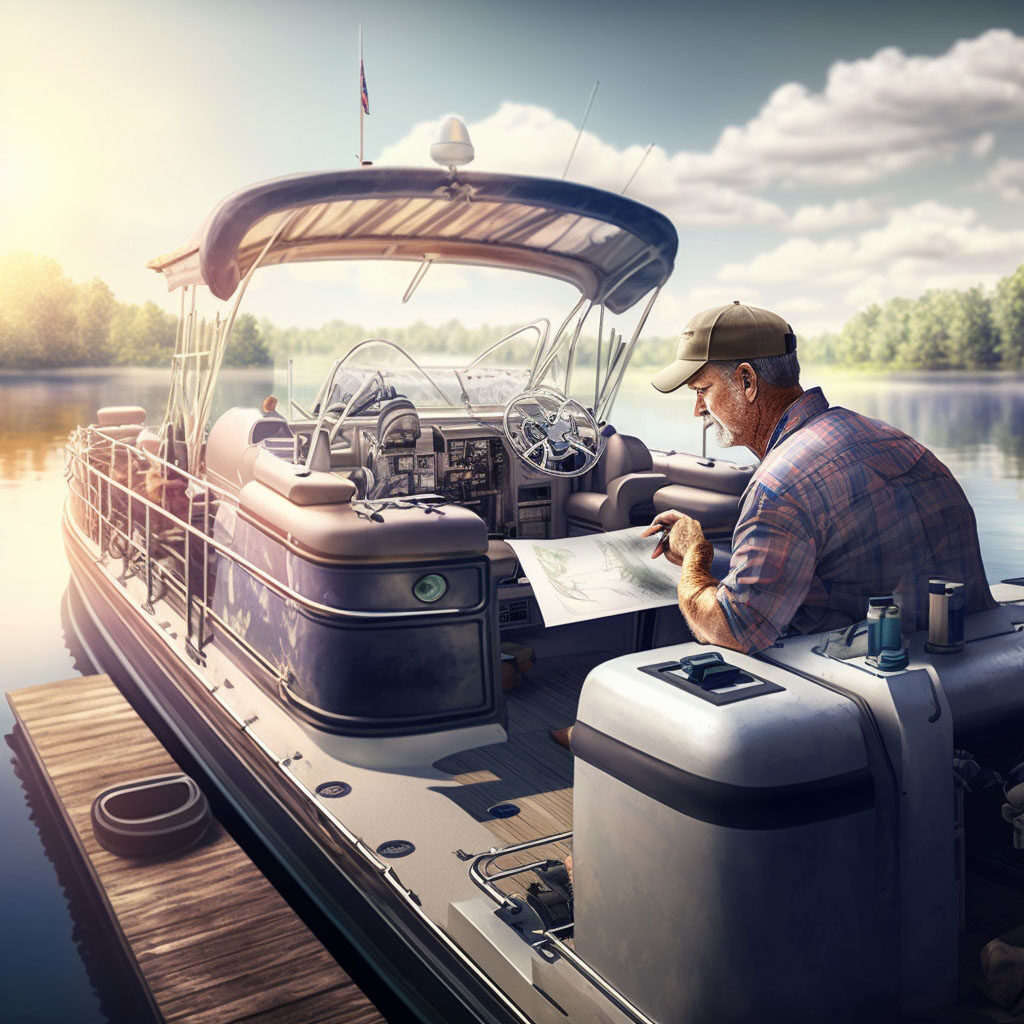
Upgrade Your Boating Experience: Adding a Third Pontoon Made Easy!

How Long Does It Take A Canoe To Go… (Canoe Calculator Here)

In-Depth Review of the Pelican Sentinel 100X Fishing Kayak: Pros, Cons, and Performance

How To Put A Kayak In The Water – The Ultimate Guide For New Kayakers

Best Cruising Catamarans For Couples
More from boating guide magazine.
- Pontoon Boat Basics
- The Complete Runabout Boat & Trailer Towing Guide
- Winterizing Your Boat
- Boating Gear Requirements For Canada And USA Waters
- Aluminum vs. Fiberglass Bass Boats
- Better Boating At Night & How To Survive The Darkness
- Staying Safe On A Catamaran: 24 Essential Tips
- Can A Catamaran Capsize?
- 4 Common Types Of Propulsion For Boats
Return To Home * About Boating Guide * About The Author
fakewatches.is

Share this post with your friends
- Tags: boat type , catamaran , catamaran basics , catamaran essentials , sailing
Subscribe to our Newsletter
Join us in our love for all things water. And Adventure.

Can One Person Sail A Catamaran? 10 Tips For Solo Sailing
Advertisement A catamaran features two equal-sized parallel hulls. It offers outstanding stability from the geometrical point of view. Though a catamaran is primarily used as a fishing boat, its fantastic stability has expanded its uses over time. It’s also used in recreational activities. A lot of people ask whether you can sail a catamaran solo?

The Poseidon 1 Underwater Drone – Best Boating Toy For Adults?
Advertisement Best Boating Toys – The Geneinno Poseidon 1 Underwater Drone Do you love to go out on boating trips? If yes, then an underwater drone is something that’ll be of great use. Not only that, but these drones are ridiculously fun to use with their built-in cameras and clever maneuvering. Believe it or not,

Everything You Want To Know About Neel Trimarans
Advertisement You can determine Neel Trimarans by the number of its hulls. A hull is the lower part of a boat that meets the water; it is that part of a ship that projects into the water. In monohulls, the hull has a keel attached to its hull. Monohulls have only one hull; as the

How Long Does A Kayak Last? 5 Awesome Materials Examined
Advertisement If you’re wondering: “How long does a kayak last?” you’ve come to the right place for answers about kayaks of various materials. Kayaks and canoes are expensive things. Some cost hundreds of dollars, so it is understandable to want your investment to last for a lengthy period. Some investigation is required to establish the

How Much Does A Catamaran Cost? (Big Crazy $$$?)
Advertisement You’ll want to know the Catamaran cost if you find sailing on lakes and fishing exciting. Then, a catamaran boat is your best bet. A catamaran is a watercraft featuring two parallel hulls. The name ‘catamaran’ is from the Tamil word, kattumaram, which means logs bound together looking like the first fishing boat designs.

Do Kayaks Tip Easily?
Advertisement Do kayaks tip easily? I wondered this myself when I first started kayaking years ago. Learning to kayak is like learning to ride a bicycle. It would be best to learn how to balance a position that may not be part of everyday life. It is a learned sense of balance that only comes

Boat Information By Type
© 2023 Boating.Guide, A Hyperwave Media Group Ltd. Publication.
Privacy Overview
- First time on a catamaran: what you need to know
During your captain training, you'll have learnt how to manoeuvre a monohull sailboat . But what about when you have the opportunity to sail a catamaran? Find out everything you need to know, including differences from monohulls, important factors to consider, pros and cons, and recommended destinations and catamaran models. If you're new to catamaran sailing, this is the perfect guide for you.
5 reasons to rent a catamaran
What are the main reasons why someone decides to sail on a catamaran? Here are the top benefits of choosing this type of boat.
1. Stability
The double hulls of a catamaran provide exceptional initial stability, allowing it to remain afloat and stable in rough waters and wind. If you're looking for a smooth and peaceful sailing experience, especially with small children or seasickness-prone individuals, a catamaran is a great option. It's perfect for taking along your grandma or a nervous friend who's never been on a boat before.
YACHTING.COM TIP: Getting seasick is not only a major worry for novice sailors, but also holidaymakers on a boat trip. But it even can affect experienced sailors from time to time. Those with darker humour say it has two phases — in the first phase you become so sick you're afraid you're dying, and in the second, you're afraid you're not going to. The important thing, though, is to understand why it happens and try to prevent it. Although you'll significantly reduce suffering from seasickness on a catamaran, what works best if it does occur? Find out in our guide — How to cope with seasickness .
A catamaran offers more space than any other boat of similar length. With spacious saloons , plenty of seating and lounging areas , and ample sunbathing spots (such as the netting known as the trampoline ), you'll never feel cramped. The cabins are roomy and the bathrooms are as big as those in many apartments. People who dislike tight spaces or value their privacy will find a catamaran ideal. On larger models (50+ feet), you'll have so much space, you may have trouble finding each other. Despite its comparable length, a catamaran always feels larger than its monohull counterpart. If you're used to a 50-foot sailboat, try a 45-foot catamaran and you'll still feel like you have more space.
3. Amenities comparable to a hotel room
Not only are the cabins spacious, but they are also comfortable and cosy. They usually come equipped with high-quality bedding, pillows, shelves, reading lamps, and more, making them feel like a proper room. That's why we wrote an article highlighting 9 reasons why a sailing holiday is better than staying at a hotel and it's doubly true with a catamaran.
4. Added extras
Catamarans often come equipped with the latest technology and gadgets. These include solar panels, generator, a seawater desalinator, a modern plotter with GPS, and autopilot . These will make you more self-sufficient at sea without needing the facilities of a marina as often.
5. Shallow draft
The reason why catamarans are so popular with sailors, especially in exotic countries , is the very shallow draft — 0.9 to 1.5 metres, depending on the length of the vessel, which means skippers don't have to concern themselves so much about hitting the seabed. While caution and monitoring charts are still necessary, it provides greater freedom in choosing anchorage spots, allowing you to sail almost right up to the beach and anchor to enjoy the peace and tranquillity.
Only small fishing boats can get as close to the shore as catamarans.
Check out articles about other boats and boating gear
Advanced sail trim techniques
The ultimate yacht cleaning kit
The most popular catamarans of 2023
How to sail a yacht on a tailwind
How to sail a yacht in crosswinds
Götheborg: the greatest sailing ship
New boats for rent in 2024
Sail trim 3: become a pro
Sailing through time: a history of sailing ships
Catamaran vs. sailboat: the main differences.
Sailors have differing preferences, with some sticking to single-hulled boats and others preferring catamarans. In fact, which is best has been a hot topic since sailing began. This makes understanding the benefits and drawbacks of each hull design essential so you can make your own choice.
1. Rental price
One major drawback of catamarans is their higher cost on the charter market. Single-hull sailboats can be rented for 1,000-2,500 euros per week, while a well-maintained catamaran typically starts at 3,000 euros per week. However, this may not be the case for all models.
YACHTING.COM TIP: If you want to save money on your catamaran charter, we recommend booking it in advance. Check out our 8 reasons why Early Bird deals are the best way to rent a boat .
2. Capacity
The higher cost of catamaran charters is offset by the extra space, comfort, and capacity — it can often hold up to 12 guests comfortably. This results in a per-person cost comparable to sailboats and cheaper than coastal hotels, making them popular for island cruising and party boats. However, for a safe and responsible party experience, we recommend checking out our guide — How to enjoy a party on a boat: 10 tips to keep your crew and your boat safe .
YACHTING.COM TIP: Never exceed the maximum capacity of the boat. And remember that even small children count as crew members.
A large crew can comfortably sail on a catamaran
3. Port charges and marina fees
Keep in mind that having two hulls means a wider boat, leading to higher docking fees . This increased width can take up more space than two smaller sailboats. However, the cost per person can be offset by the fact that more people can be accommodated.
4. Speed vs. consumption
Catamarans typically feature two high-powered engines , making them faster than similar-sized sailboats. Even without the power of the wind, you can be flying across the waters and with a better fuel efficiency than motor boats.
Catamarans typically have two basic sails: the mainsail and the foresail and operating them follow similar principles as on single-hulled sailboats. Self-tacking jibs can also be used, reducing the work required to trim and manoeuvre the sails.
For those looking to enhance their sailing experience, a gennaker can often be rented with the catamaran, providing added benefits, especially in light wind conditions. Take a look at our 5 reasons to rent a gennaker .
6. Flybridge
This elevated deck is a common feature on catamarans. Here you'll find the helm station and sometimes additional seating or lounging space. It is a valuable addition that provides extra living space on the boat.
The catamaran's second deck provides another spot to sit and enjoy views of the ocean
Who is the catamaran suitable for?
Catamarans are the preferred choice for a group of friends wanting a laid-back holiday on the water but are also popular for corporate team-building events and specialised stays like yoga. As their spacious deck provides a safe play area for children , they are also ideal for multi-family vacations.
YACHTING.COM TIP: If you are sailing with small children, safety is paramount. So, check out our guidelines for safe boating with kids , our article on how to survive on a boat with kids , the Skipper mom logbook: sailing with a baby and always try to stick to the 4 essential tips for smooth sailing with kids . If you don't have kids or don't want to bring them along, why not take your four-legged friend? Catamarans offer ample space for dogs to run around, and following these 7 tips can help make your pet a true sea dog.
On the other hand, we wouldn't suggest a catamaran to sporty sailors to chase the wind in, as the catamarans for charter aren't intended for racing or regattas. Due to their design, they have limited upwind capabilities (sailing boats can sail up to 30° wind angle, while charter catamarans can only handle up to 50° to 60° wind angle), making them unsuitable for competitive sailing.
YACHTING.COM TIP: If you have doubts about your ability to safely operate the boat, consider hiring a skipper. We can arrange a skipper for you who is knowledgeable about the area and can take care of the navigation for you or teach you any sailing skills you may be lacking. Remember when planning that the skipper will occupy one cabin or berth in the saloon.
Specifics of sailing on a catamaran
The principles of sailing a catamaran are similar to those of a monohull sailboat, but there are some differences to keep in mind. These may have already been covered in your captain's training course.
Travelling on the engine
A catamaran has two motors , each of which can be controlled separately using its own throttle control. Want to turn on the spot? That's no problem at all with a catamaran — simply add throttle with one motor and reverse with the other. Once you get the hang of this trick, you'll no longer need a bow thruster, although catamarans are sometimes equipped with one. This makes docking your catamaran a breeze compared to single-hulled sailboats.
Travelling on the sails
Sailing varies mainly in what courses you can sail and how strong the winds are. Most charter catamarans perform best on courses at 50 to 60 degrees to the wind. This is a greater angle compared to sailboats. So be prepared to have to adjust your planned route.
If you sail a sailboat too hard, the boat itself will tell you that you've over-steered by heeling. A catamaran won't do that, so you have to be very attentive to when to reef the sails. Usually, you will put in the first reef at a wind speed of 18 to 20 knots and the second reef at 23 to 25 knots.
Best destinations for catamaran sailing
In addition to the more traditional locations of Croatia , Greece , Italy , Spain and Turkey , we rent catamarans all over the world. In these destinations, you appreciate plenty of space , comfortable access to the water via steps, stability on the waves and amenities such as a barbecue and air conditioning .
However, catamarans are perfectly suited for more exotic destinations . In remote locations, the low draft comes in particularly handy as the seafloor is often poorly charted and the beaches are stunning. The large water and diesel tanks, along with an electricity generator, a desalinator to produce fresh water from seawater, and solar panels are especially useful in exotic locations where the yachting infrastructure is less developed. These features help sailors to be self-sufficient and avoid the need to find a dock every few days.
Popular destinations for catamaran sailing include the beautiful Seychelles , Thailand , French Polynesia and the Caribbean (Grenada, St. Lucia, Martinique, Antigua, St. Martin, Cuba , British Virgin Islands, Bahamas, and Belize).
YACHTING.COM TIP: Don't be apprehensive about sailing to more tropical destinations! Check out our guide to exotic sailing holidays . If you are headed to these warmer climes, you will need to find out when the rainy season or the hurricane season starts.
Views in the Caribbean are picture perfect
The most popular catamarans
Popular charter catamaran brands include Lagoon , Bali , Fountaine Pajot , Nautitech , and Leopard . These are the models that have received positive feedback from our clients for years and that we confidently recommend.
The Lagoon 380 offers a true sailing experience, or the larger Lagoon 46 , where you may end up spending the whole morning lounging in its spacious cabin.
The Bali cat space provides amazing seating up at the helm.
The Fountaine Pajot Elba 45 where you'll enjoy relaxing at the bow on the seating or the trampoline.
The Nautitech 46 with its huge saloon.
The Leopard 45 with its gorgeous bright interior, or the Leopard 50 that's so luxurious, you'll feel like a king.
YACHTING.COM TIP: For the discerning sailor, the Lagoon 620 and Dream 60 large catamarans are also worth mentioning. However, it's important to note that most captain's licenses are not valid for these giants and you'll need to hire a professional skipper.
Special types of catamarans
Catamarans have been around for quite some time, leading shipyards to continuously innovate and create new models with unique features and characteristics. So, what are some of them?
Power catamaran
The popularity of power catamarans has been increasing lately due to the fact that they provide the stability and spaciousness of a catamaran without the need to handle sails.
Do you believe that more is always better? Not satisfied with just two hulls? Then we have a unique chance for you to rent a trimaran , a three-hulled catamaran that offers an unparalleled sailing experience. Trimarans are still rare, so you're sure to attract attention wherever you go.
All catamarans in our offer:
Not sure if you want a catamaran or a sailboat no problem, we'll be happy to assist you in finding the perfect vessel. just let us know..

Denisa Nguyenová
Faq sailing on a catamaran.
What are the main differences between a sailboat and a catamaran?
- Number of hulls = stability
- More space = higher passenger capacity
- Higher charter and port charges
- Speed per engine
- Yacht Charter
- Yacht Experiences
- My Boataffair
What Is a Catamaran?
If you’re thinking of chartering a catamaran on your next trip, read through our guide and get up to speed on two hulled yachts! We offer Catamarans for charter in over 60 countries and the entire selection can be seen on our Catamaran charter page.
A Catamaran is a sail or engine-powered boat with a double hull, a distinct feature that makes it immediately recognizable once you're aware of the design. People often question whether a catamaran is a yacht, and due to the sleek style, versatility, speed capabilities, and comfort, a catamaran definitely earns the yacht stamp of approval. Due to these same characteristics, catamarans are becoming an increasingly popular choice among avid leisure and sport sailors.
The elegant and unique catamaran style isn't a new development - it's actually a centuries-old design that's been modified and built upon to become what it is today.
The first Catamaran was created in India, borrowing its modern name from the original Tamil word kattumaram, meaning "logs bound together". The first design was simply a raft made of tree trunks, built in the fishing communities of Tamil Nadu in southern India and used to invade several Southeast Asian countries as early as the 5th century. The kattumaram quickly became the favoured vessel style throughout Polynesia and Micronesia.
Evolved by American Nathanael Herreshoff in the 1870s and further developed in the 1950s, the catamaran concept really took off in the 20th century. It was soon functioning as a full-fledged yacht, able to compete in the racing arena with mono-hulled boats without compromising luxury. Nowadays, catamarans attract both sport and leisure boaters with its versatility, speed, and comfort.

What are the Characteristics of a Catamaran Hull?
The most obvious characteristic of a catamaran is the twin hull, but there are more benefits to the cleverly crafted underside. When compared to a monohull yacht of the same size, the catamaran hull has several big advantages. Catamaran hulls are noted for having less volume, lighter displacement, and shallower draft (ie less of the boat is below water) when compared to monohull vessels. The shallow draft is especially appealing, allowing for use in shallow water and giving the captain the option to pull the boat right up to shore without worry.
Additionally, because of the hull design, catamarans boast a smaller hydrodynamic resistance, ultimately making them more economic since they don't need as much fuel to propel them forward. And for those sailors still strengthening their sea legs, the double hull increases the catamaran's overall balance and stability by reducing the amount of wave-induced motion. So long seasickness!
Catamarans have a lot of space. The living area in between the two hulls offers a dining and lounging area as well as a spacious kitchen. You also find outside lounging areas at the back and in the front of the yacht. The various places to relax mean a lot of privacy on board. The two hulls further increase the privacy aspect because the cabins are separated by the central living area and each hull has their separate entrance in most cases. This makes the Catamaran the ideal yacht to charter for two couples, two families, a group of friends or a large family. The cabins in the hulls are spacious and comfortable and their sizes vary with the exact Catamaran model.
So in summary, catamarans:
- have two hulls, usually connected by a bridgedeck
- can be sailed in shallow water
- use less fuel, because they have low hydrodynamic resistance
- tend to be very stable
- have a lot of space for dining and lounging and preparing food
- offer greater privacy than monohull yachts
To give you an idea of the space and amenities on board a Catamaran, do have a look at the many pictures of our Fountain Pajot Alegria 67 for charter in the British Virgin Islands .
How to Sail a Catamaran
You're sold on the idea of a catamaran, but now comes the question, how hard is it to sail a catamaran? Learning how to sail a catamaran is relatively straight forward if you're already trained in the basics of sailing. Although it does differ from monohull vessels, the idea is the same. Be prepared to tweak your sail trimming skills and get used to the difference in motion (or lack thereof) with the catamaran.
The catamaran is gaining popularity because the better-balanced hull and twin engines make it arguably easier to operate than a monohull yacht. Fluid maneuverability means that even one person can sail a catamaran as long as they've built up enough sail experience. Still, it's never a bad idea to get some formal training; the ASA and RYA both offer catamaran sailing courses to help enhance your skills.
How Fast Can a Catamaran Sail?
Catamaran's can cruise! Their speed is just another reason why the boat has become so sought-after in recent years. A sailing catamaran can typically perform 25% - 30% faster than a monohull of the same size.
So just how fast can they go? Cats average about 10 knots with top speeds reaching around 15 knots. Just keep your weight in mind - catamarans respond sensitively to heavy loads and will perform slower if overweight.

Why Charter a Catamaran?
When compared to a monohull boat of the same size, a catamaran has a tendency to be a bit more expensive to charter. However, your trip itinerary might require certain criteria that make spending a bit more worth it. For example, the flat plane and stability of a catamaran are ideally suited for a family to enjoy their holidays in a lot of comfort. It is also ideal for a scuba diving holiday , allowing divers to gear up and enter/exit the water with ease. Additionally, big parties usually find catamarans better suited for their needs in terms of deck space and overall comfort.
A Catamaran is the ideal yacht for a relaxing vacation as it boasts a lot of space, stability and living spaces - it truly is your floating hotel. But note that a catamaran holiday does not need to break the bank and is very affordable in comparison to a vacation in a hotel or a villa depending on the type and size of a catamaran you decide to go for.
***************************
Catamarans are a fun alternative to the traditional sailing yacht and the value for money is unrivalled for a yacht holiay. They provide comfort, flexibility and a lot of space to spend your time on the sea. You can also check out this Comprehensive guide to chartering a yacht for more information.
Curious? Check out Boataffair's huge choice of catamarans to charter in the world's most sought after destinations.

- Frequently asked questions
- Yachts for Charter
- Experiences
- E-Gift cerificates
- Browse yachts by type
- Terms of Use
- Privacy Policy
- Terms of Use E-Gift Card
- Boataffair AG
- Schuetzenstrasse 43
- 5454 Bellikon
- Switzerland
- Send a message
- [email protected]
- +41 78 612 29 19
- Rating: 5.0 / 5.0 Average from 180 reviews
- See our customer reviews

- 2024 BOAT BUYERS GUIDE
- MIAMI BOAT SHOW
- Email Newsletters
- Fishing Boat Reviews
- Fly Fishing
- Marine Electronics
- Fishing Tackle
- Fishing Destinations
- The Bahamas Fishing Guide
- Boating Safety

2023 Boat Buyers Guide: Catamarans
- By Karl Anderson
- December 27, 2022
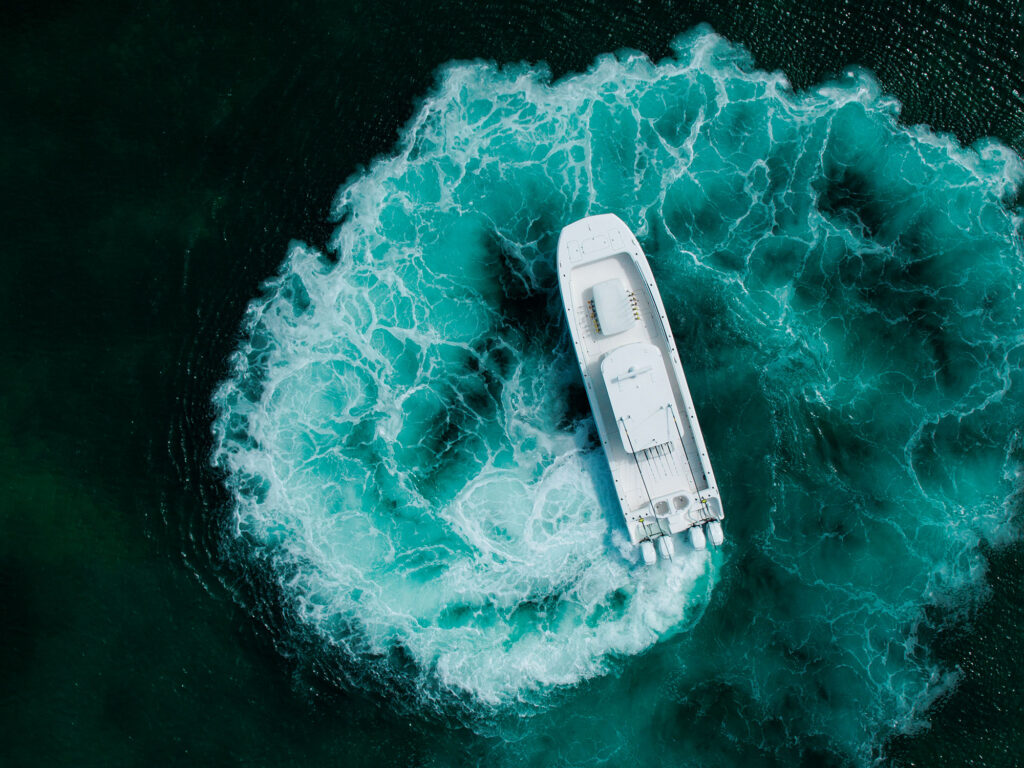
The popularity of the multihull (aka catamaran or cat) fishing boats has never been greater, as more and more boatbuilders enter this growing segment of the market. The inherent stability of the catamaran design rolls less with the seas, making fishing offshore less tiresome and more comfortable. Available from 20 to 48 feet, catamarans typically offer a large fishing platform with generous storage and fishing amenities. They are available in a wide variety of deck layouts, including center-consoles, dual-consoles, and even pilothouse and express variants.
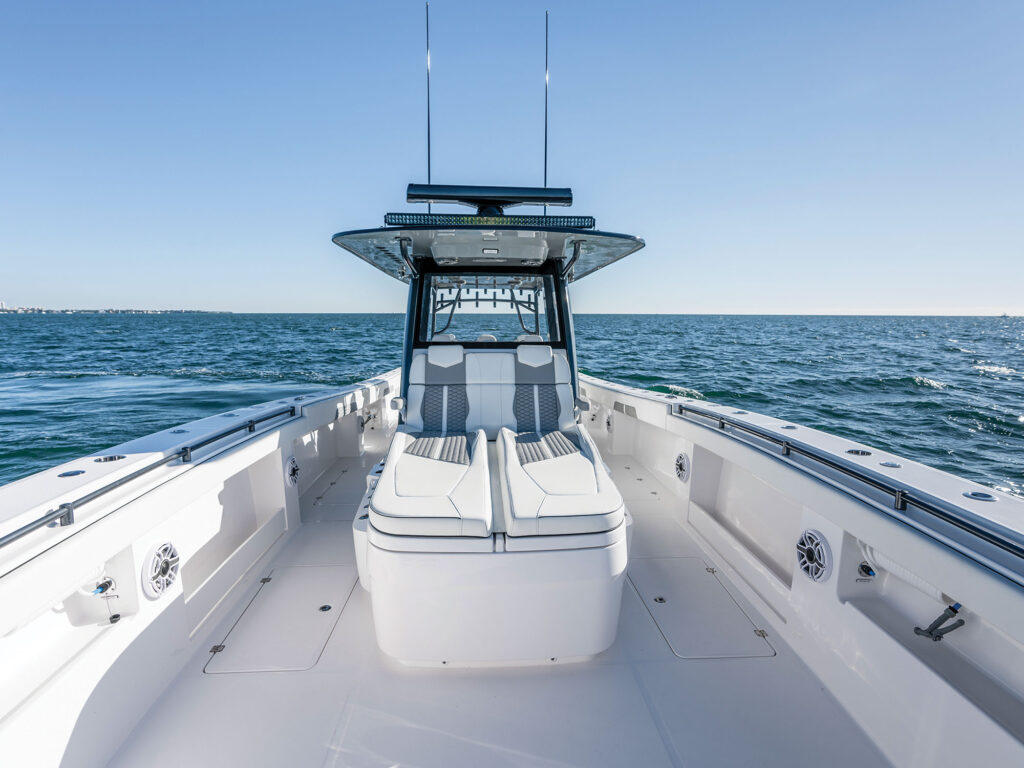
Big Picture
The large deck area of a catamaran enables many large underdeck storage lockers and insulated fish boxes in the sponsons. This gives anglers ample room for gear and the day’s catch. The catamaran’s stability, fishability, and smooth ride in rough seas make it attractive to anglers as well as day-cruisers. A center-console version adds 360 degrees of angler access to the rail. With the dual-console design, generous seating behind a beam-to-beam windshield makes for a great family fishing-friendly setup.
Live bait is one of the most popular types of fishing in virtually every coastal zone. To do it successfully requires optimal water capacity and proper flow. The minimum size of the outflow water plumbing should be twice the size of the inflow. The plumbing should have a drain at the bottom to shed scales at the end of the day, as well as a drain at the top of the well to adjust capacity and allow overflow. Above-deck transom-mounted wells should fully flood to the lids when running to keep baits from getting beat up.
Tip: A sump box with multiple pumps in case a pump fails is the best setup for first-rate livewells. Conveniently located inflow and outflow valves make it easy to optimize the flow without tiring your bait from swimming too much in the well.
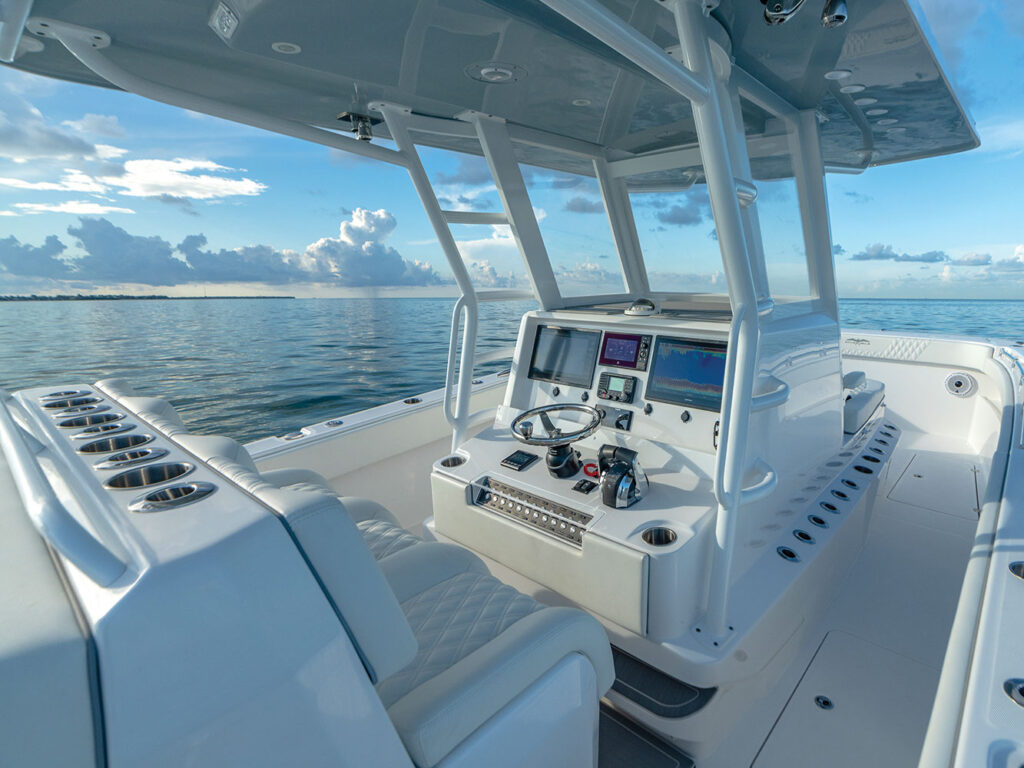
Rod Storage
Having enough rod holders is essential to be successful for opportunity fishing. Look for vertical rod storage along the console and across the back of the T-top. Many models also have rod holders along the outboard transom wall. Having plenty of gunwale rod holders for drift- and kite-fishing is helpful.
Tip: Placing adjustable swivel rod holders by Gemlux makes deep-dropping, lure-fishing and drifting even easier because they allow your rods to face the direction the baits are fishing, yet they can be swiveled back to keep rods from sticking out of the boat while running and docking.
Manufacturers often offer multiple choices for horsepower, but whatever the choice, the engines must come in pairs. For example, you might order twin outboards (one for each sponson) or four outboards (two for each sponson), but single- or triple-outboard configurations are not common on a cat. Optimal selection should be made based on user load, weight of the boat, ride comfort , performance desires, and best case for resale. It’s a rare day when you can run wide open, but having more horsepower gives better torque at slower speeds and thus better control. Running larger engines slower gives better fuel efficiency too.
Tip: When possible, choose the highest horsepower offered because it typically leads to a better resale value with a shorter sales cycle.
Power steering from engine manufacturer Optimus or SeaStar is essential with the higher horsepower required for larger boats, and it makes installing and operating the upper station in a tower far more practical and comfortable.
With the power demands of electronics, livewell pumps, stereo amps and more, it is wise to have at least two house batteries, and for larger boats, a third or fourth with a multibank charger for dockside. Each engine should have its own dedicated battery as well.
Electronics
Typically choosing the largest screen or multiple screens that will fit on the console is best-case scenario for ease of use, ergonomics, and visibility. VHF radios, stereo controller, and equipment switches for lighting, pumps, and accessories should all be integrated with greatest visibility and ease of operator reach.
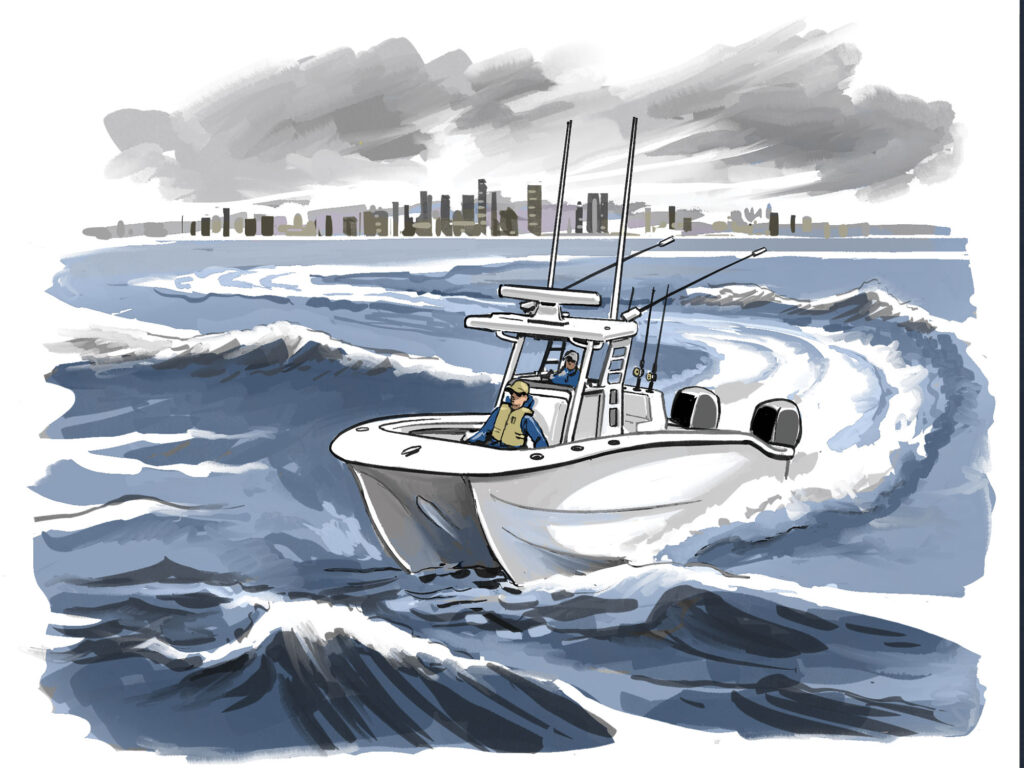
A Tale of Two Hulls
A catamaran rides on pair of hulls, or sponsons, each thinner and sharper than that of a similarly sized monohull boat. The narrow sponsons of the cat tend to slice easily through water to deliver a smooth ride, even in rough seas. At the same time, with the sponsons positioned out to the sides of the boat, cats tend to roll less, thus providing great stability to enhance crew comfort, security and safety. However, cats tend to corner more flatly than a monohull, and some hulls (but not all) tend to lean outward versus inward during a turn.
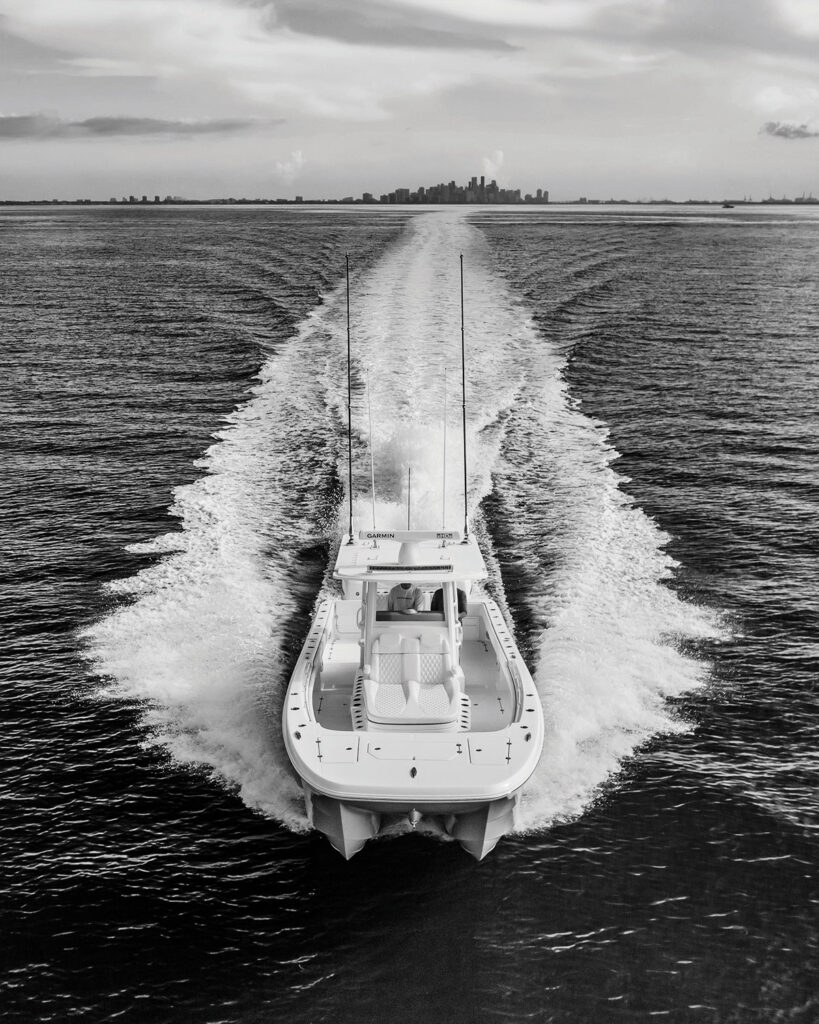
Experts Say
Newer designs such as Invincible’s Morelli and Melvin-designed semi-asymmetrical sponsons eliminate some of the negatives of the cat design, such as “sneezing,” where water sprays out the front of the boat when hitting a wave. They’ve also controlled the uncomfortable “outboard lean” sensation common in older designs when in a turn. Once transitioned to a catamaran, many become true believers and preach the benefits of the design.
Editor Says: Saltwater fishing cats not only offer superb stability and smooth ride, but some also display exceptional speed and range. I recall one trip out of Key West, Florida, aboard an Invincible 40 Cat with four 350 hp outboards to the Dry Tortugas. It was a 60-mile run, and we made it there in 70 minutes. We caught more fish than our arms could bear, and then dashed back to Key West, arriving in time for cocktail hour on the same day. -Jim Hendricks, Staff Editor, Boating and Fishing Group
- More: 2023 Boat Buyers Guide: More Resources , Boats
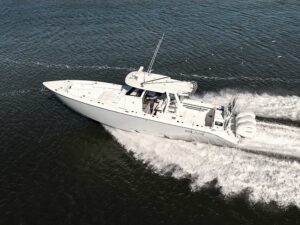
Solace 37CS
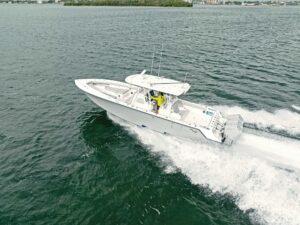
SeaVee 400Z
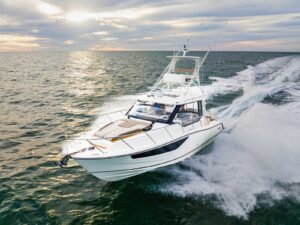

Salt Water Sportsman On Board: Boston Whaler 365 Conquest
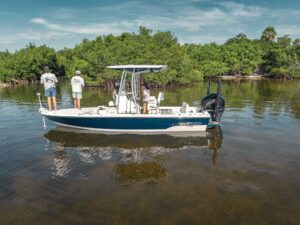
Pathfinder 2200 TRS

The Science of Gamefish

Targeting Redfish in the Georgia Bight

Vermilion Rockfish Limit Cut in Half in California Waters

- Digital Edition
- Customer Service
- Privacy Policy
- Cruising World
- Sailing World
- Salt Water Sportsman
- Sport Fishing
- Wakeboarding

Mastering Catamaran Sailing: Learn How to Sail a Catamaran like a Pro
Alex Morgan
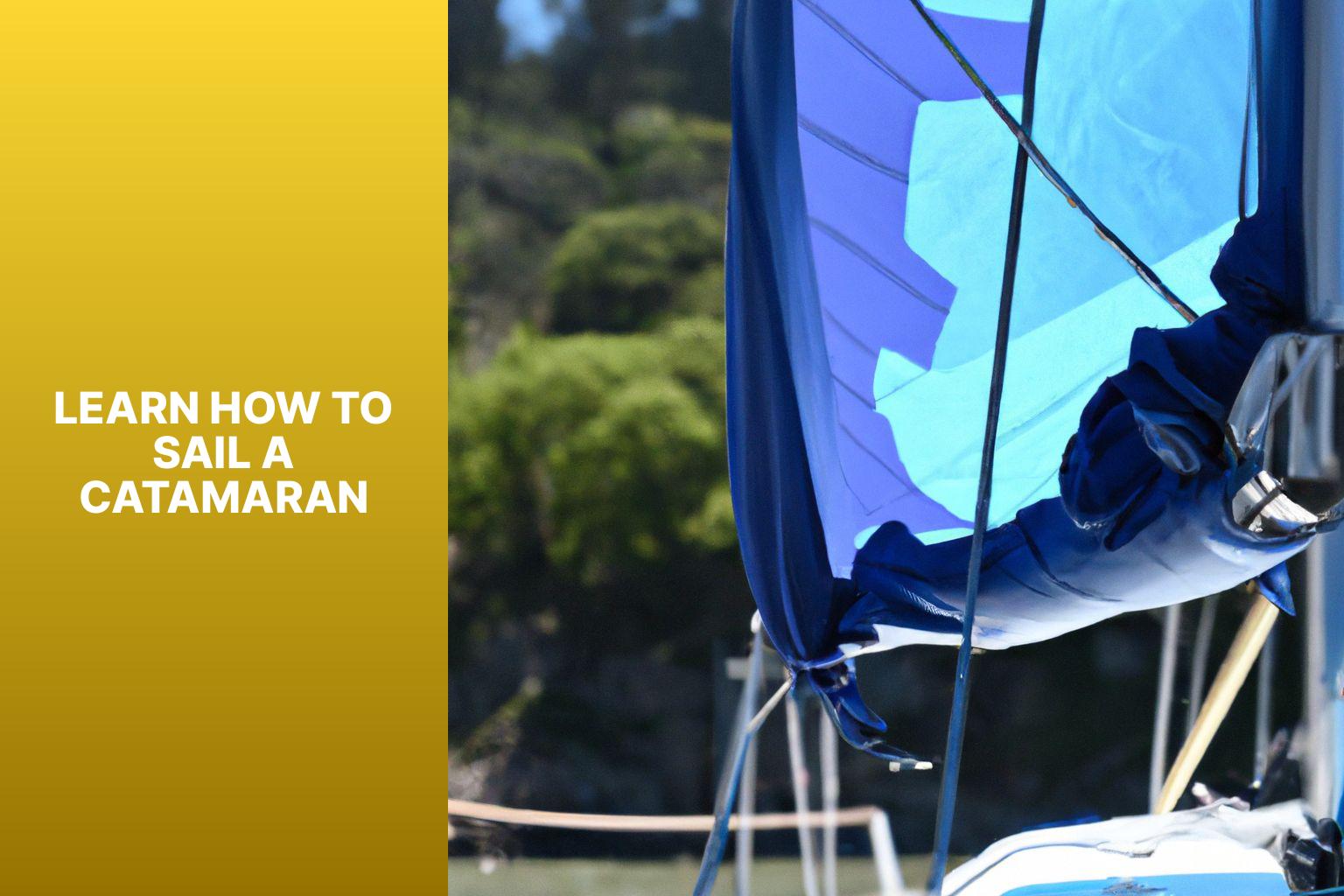
Sailing a catamaran is an exhilarating experience that allows you to harness the power of the wind and navigate the open waters with agility and speed. If you’re interested in learning how to sail a catamaran, it’s essential to understand the basics, prepare properly, learn key sailing techniques, and acquire navigation skills specific to catamarans. This comprehensive guide will provide you with the necessary knowledge and techniques to confidently sail a catamaran.
Introduction to Sailing a Catamaran
Sailing a catamaran offers a unique sailing experience with its twin hulls, stability, and spacious deck. Before diving into the specifics, it’s important to understand the fundamentals of catamarans and how they differ from monohulls.
Understanding the Basics of a Catamaran
To fully grasp the art of catamaran sailing, you need to first comprehend what a catamaran is and how it differs from a monohull. This section will provide a clear definition of a catamaran and highlight its distinctive features.
Preparation for Sailing a Catamaran
Before setting sail, proper preparation is crucial to ensure a safe and enjoyable experience. This section will cover essential steps such as conducting safety equipment checks, understanding wind and weather conditions, and making necessary preparations for sailing a catamaran.
Key Sailing Techniques for Catamarans
Mastering key techniques is essential to maneuvering and controlling a catamaran effectively. This section will delve into important skills such as steering and maneuvering, sail trim and adjustment, tacking and jibing, and understanding points of sail specific to catamarans.
Navigation and Seamanship for Catamarans
Navigating a catamaran requires a solid understanding of chart reading, course planning, and the rules of the road. This section will provide guidance on reading nautical charts, planning routes, and understanding the right-of-way rules when sailing a catamaran.
Recovering from Common Sailing Challenges
Even with proper preparation, sailors may encounter challenges while on the water. This section will address common issues such as capsize and the techniques for righting a catamaran, as well as strategies for dealing with strong winds and heavy seas.
Additional Resources for Learning Catamaran Sailing
To further enhance your knowledge and skills in catamaran sailing, this section will provide a list of helpful resources, including books, online courses, and sailing clubs, where you can continue your learning journey.
By following this guide and honing your skills, you’ll embark on a rewarding adventure as you navigate the seas with confidence and expertise in sailing a catamaran.
Key takeaway:
- Learning to sail a catamaran maximizes your sailing experience: Sailing a catamaran allows you to navigate the waters in a unique and exciting way, enhancing your overall enjoyment of the sport.
- A catamaran offers a different sailing experience from a monohull: Understanding the basics of a catamaran helps you appreciate its distinct characteristics, such as stability and speed, compared to traditional monohull sailboats.
- Being prepared and understanding key sailing techniques are crucial: Prioritizing safety, learning about necessary equipment, and mastering sailing techniques like steering, sail trim, and tacking ensure a successful and enjoyable catamaran sailing experience.
A catamaran is a boat with two parallel hulls connected by a bridge. Understanding the basics of a catamaran is important to fully enjoy the unique sailing experience it offers. These hulls provide stability and reduce drag, enabling higher speeds. Catamarans are used for sailing , cruising , and racing .
The design allows for a spacious interior layout, making it ideal for leisure activities or living aboard. One advantage of a catamaran is its shallow draft , which allows for navigation in shallower waters . When sailing, it’s crucial to have a good grasp of the components like the mast , sails , rigging , and helm . Learning how to trim the sails and adjust the rigging optimizes performance. Maneuvering the catamaran, including tacking and jibing , controls direction and speed.
Safety is paramount, so having a clear understanding of safety procedures and possessing the necessary equipment is essential. With a thorough understanding of the basics, you can confidently enjoy the unique sailing experience a catamaran offers.
What is a Catamaran?
A catamaran, also known as a cat , is a type of boat with two parallel hulls connected by a deck. It is specifically designed to prioritize stability, achieved through a wider base and weight distribution. Catamarans are renowned for their spaciousness and maneuverability , making them a popular choice for sailing and cruising enthusiasts.
One notable advantage of a catamaran is its ability to achieve higher speeds compared to monohulls . This can be attributed to the wide hulls, which result in less drag and enable faster and smoother sailing experiences. The dual hull design enhances stability , reducing the likelihood of rolling or capsizing , particularly in rough waters.
Catamarans also offer a significant advantage in terms of living space and comfort . Thanks to the presence of two separate hulls, these boats can accommodate cabins , lounges , and various amenities. As a result, catamarans are considered ideal for long-distance cruising or liveaboard experiences , providing ample room for relaxation and enjoyment .
When it comes to sailing performance, catamarans excel in upwind capabilities and have the ability to sail closer to the wind compared to monohulls. They are easier to maneuver and require less effort to handle, making them an excellent choice even for beginners embarking on their sailing journey .
How is a Catamaran Different from a Monohull?
Catamarans have greater stability than monohulls due to their wider beam and two hulls. This stability reduces tipping and rolling in rough seas.
Compared to monohulls , catamarans have a shallower draft, allowing them to navigate in shallow waters and anchor closer to the shore.
Catamarans provide more interior space with their wider beam, resulting in larger cabins, living areas, and storage compartments.
Catamarans are known for their speed. The twin hull design reduces drag, enabling them to sail faster than monohulls , particularly in light winds.
In terms of sailing motion, catamarans have a flatter and more stable movement, offering increased comfort for those prone to seasickness. They also have better maneuverability and can sail closer to the wind compared to monohulls .
Pro-tip: If you desire a spacious, stable, and fast sailing experience, a catamaran is an excellent choice. Its unique design provides comfort and performance, making it a popular option for cruising and long-distance sailing.
Prepping your catamaran for an epic sailing adventure? Get ready to set sail with confidence as we dive into the vital elements of catamaran preparation. From essential safety equipment and thorough checks to mastering the art of reading wind and weather conditions, we've got you covered. Safety first and a keen understanding of the natural elements will ensure smooth sailing and unforgettable experiences on the open water. Let's dive into the nitty-gritty details and get you fully prepared to harness the power of the winds and conquer the seas!
Safety Equipment and Checks
When sailing a catamaran, it is essential to prioritize safety. It is important to follow these steps for safety equipment and checks:
- First and foremost, inspect the life jackets to ensure they are in good condition and functioning properly.
- Take the time to check the throwable flotation devices and ensure they are readily available and in working order.
- Verify that the catamaran has a properly installed fire extinguisher, which is crucial in case of any fire emergencies.
- Make sure that distress signals, such as flares or emergency signaling devices, are present and easily accessible.
- It is vital to inspect and test the bilge pump to make sure it is functioning correctly and can effectively remove any water from the boat.
- Check the navigation lights to ensure they are properly functioning, as they are essential for visibility during nighttime or low-light conditions.
- Verify the availability and condition of a sound signaling device, such as a horn or whistle , which can alert others in case of emergencies.
- Ensure that the catamaran is equipped with a VHF radio or other communication devices for effective communication during emergencies.
- Inspect the anchor and anchor line to ensure their good condition, as they are crucial for securing the catamaran in place.
- Check the availability and condition of navigation charts and a compass, which are essential for proper navigation and orientation.
Pro-tip: It is highly recommended to regularly inspect and maintain all safety equipment to ensure they always work properly. Performing safety checks before every sailing trip is crucial to ensure the well-being and safety of everyone onboard.
Understanding Wind and Weather Conditions
Understanding wind and weather conditions is essential when sailing a catamaran. It is crucial to consider wind direction, wind strength, and current weather conditions in order to plan your sail effectively and ensure a safe and enjoyable experience.
Having a good understanding of wind direction is vital while sailing. By adjusting your sails accordingly, you can maximize the power and efficiency of your catamaran. Knowing the strength of the wind can help you determine the appropriate sail trim and make adjustments for optimal performance .
Weather conditions play a critical role in ensuring safety while sailing. It is important to check weather forecasts before setting sail and to remain aware of potential changes in weather patterns. Understanding the possibility of storms, strong winds, or heavy seas allows you to make informed decisions on when it is safe to sail and when it is best to stay ashore.
By understanding wind and weather conditions, you can effectively plan your sail, adjust your sails for optimal performance, and ensure the safety of yourself and your crew. Continuously monitoring and assessing these conditions throughout your sailing journey allows for well-informed decisions and contributes to a successful and memorable experience on your catamaran.
Get ready to set sail and master the art of catamaran sailing with these key techniques! We will unravel the secrets behind steering and maneuvering, sail trim and adjustment, tacking and jibing, and understanding the points of sail . From controlling the direction of your catamaran to optimizing your sail position, this section has got you covered with practical tips that will enhance your sailing skills. So, hop on board and let’s embark on a thrilling sailing adventure !
Steering and Maneuvering
When steering and maneuvering a catamaran, it is important to keep in mind the following techniques:
- Use the tiller or steering wheel to control the direction of the catamaran. Push the tiller away from you to turn the catamaran to starboard (right), and pull the tiller towards you to turn the catamaran to port (left).
- Work closely with the crew and communicate clearly to ensure smooth maneuvering. Assign specific roles and responsibilities to each crew member, such as trimming the sails or adjusting the daggerboards .
- Adjust the sails accordingly to optimize the catamaran's performance. Trim in the mainsail and jib to generate more power and speed, or ease the sails to reduce power in strong winds.
- Pay attention to the catamaran's speed and steer accordingly. A faster catamaran may require more precise and proactive steering to maintain control.
- Practice tacking and jibing techniques to change direction smoothly. Tacking involves turning the bow of the catamaran through the wind, while jibing involves turning the stern of the catamaran through the wind. Always be mindful of the wind direction and adjust your maneuvering accordingly.
By mastering these techniques, you'll be able to navigate your catamaran with confidence and precision.
Sail Trim and Adjustment
For optimal performance and stability of a catamaran, sail trim and adjustment are essential. Follow these steps to ensure proper sail trim:
- Begin by checking the telltales of the main sail to ensure smooth flow without any fluttering or stalling.
- Next, focus on the jib or headsail and adjust the sheet tension to achieve proper trim and generate lift.
- Paying attention to the traveler position is crucial. Move it accordingly to control the boom angle and sail shape based on wind conditions.
- Adjust the halyard tension to prevent any sagging or fluttering.
- Continuously monitor and adjust the tension in control lines, such as the jib sheet and mainsheet , to achieve the desired sail shape and balance.
- While sailing, constantly assess the sail trim. Observe the telltales, listen to the wind, and take note of any changes in speed. Fine-tune the trim for optimal performance and control.
By consistently adjusting sail trim based on changing conditions, you’ll ensure a pleasurable and efficient catamaran sailing experience.
Tacking and Jibing
Sailing a catamaran requires a good understanding of the techniques for tacking and jibing . Here are the steps to master these maneuvers:
- To change direction when the wind shifts, turn the helm or the wheel away from the wind.
- Release the jib sheet and let the jib sail luff as the bow of the catamaran passes through the wind.
- Trim in the jib sheet on the new tack to regain speed and control.
- Ease out the mainsail sheet and move the boom to the opposite side of the catamaran.
- Steer the catamaran downwind to swing the mainsail across the boat.
- Switch the mainsail sheet to the new side and trim it in to stabilize the sail as the mainsail crosses over.
Pro-tip: It is advisable to practice tacking and jibing in light winds before attempting these maneuvers in stronger conditions. This will help build confidence and develop a solid understanding of the catamaran’s handling characteristics.
Understanding Points of Sail
To gain a comprehensive comprehension of Understanding Points of Sail , it is important to acknowledge the various angles at which a sailboat can navigate in relation to the wind.
The initial point of sail is referred to as the “no-sail zone,” during which the wind is directly facing the boat’s front, making it impossible for the sails to catch the wind.
Subsequently, we have the “close-hauled” or “upwind” point of sail, where the boat skillfully sails as close to the wind as possible without stalling. In this scenario, the sails are meticulously adjusted to create lift and propel the boat forward.
Moving on, the “close reach” point of sail occurs when the boat is slightly angled away from the wind, enabling the sails to fill and generate power.
As for the “beam reach” point of sail, the boat is positioned at a right angle to the wind, causing the wind to blow directly onto the side of the sails. This results in the boat achieving the desired speed and momentum.
On the other hand, the “broad reach” point of sail sees the boat sailing at an angle away from the wind, which allows the sails to fill more and generate even greater speed.
We have the “downwind” or “running” point of sail, where the boat sails directly with the wind coming from behind. To ensure an efficient catch of the wind, the sails are let out as far as possible in this scenario.
Acquiring a solid understanding of points of sail is paramount when it comes to taking control of the direction and speed of a catamaran, ultimately maximizing its performance. By skillfully adjusting the sails and steering according to the various points of sail, sailors are able to effectively navigate their catamarans, ensuring a smooth and efficient sailing experience.
When it comes to sailing a catamaran, one crucial skill to master is navigation and seamanship . In this section, we’ll dive into the essentials of chart reading and course planning , helping you plot your path with confidence on the open waters. We’ll explore the rules of the road and right-of-way , ensuring you understand the fundamental principles of safe sailing. So, sharpen your skills and join us as we navigate the captivating world of catamaran seamanship !
Chart Reading and Course Planning
When sailing a catamaran, chart reading and course planning are essential for a safe journey. Understanding and properly navigating charts will help you choose the best route and avoid potential hazards. The following table outlines key aspects of chart reading and course planning for catamaran sailing:
By mastering the skills of chart reading and course planning, you can confidently and safely navigate your catamaran, maximizing your enjoyment of the sailing experience.
Rules of the Road and Right-of-Way
To sail a catamaran safely and avoid collisions, it’s crucial to understand the Rules of the Road and Right-of-Way .
- Sailboats fall under the International Regulations for Preventing Collisions at Sea (COLREGS) , which provide guidelines for preventing accidents in various situations.
- According to the Rules of the Road , when two sailboats approach each other on different tacks, the boat on the starboard tack has the Right-of-Way and the boat on the port tack must keep clear.
- When a sailboat approaches a power-driven vessel, the sailboat must yield and keep clear of the power-driven vessel’s path.
- When overtaking another sailboat, the overtaking boat is responsible for keeping clear and avoiding a collision.
- It’s important to understand and follow these Rules of the Road and Right-of-Way to ensure the safety and well-being of everyone on the water.
I was sailing my catamaran on a sunny day when I spotted another sailboat coming towards me. Realizing we were on a collision course, I acted quickly and adjusted my course to give way to the other sailboat, which was on the starboard tack. By following the Rules of the Road and Right-of-Way , we avoided a potentially dangerous situation and continued enjoying our day on the water. This experience highlights the importance of sailors being knowledgeable about the Rules of the Road and Right-of-Way for a safe and enjoyable sailing experience.
Navigating the unpredictable waters of sailing can come with its fair share of challenges. In this section, we’ll delve into practical techniques for recovering from common sailing mishaps, empowering you to conquer any situation with confidence. From capsize and righting a catamaran to dealing with the relentless forces of strong winds and heavy seas, we’ll equip you with the necessary knowledge to overcome these hurdles and keep your sailing adventure afloat. So, let’s dive in and uncover the secrets to mastering the art of recovery on the open waters!
Capsize and Righting a Catamaran
Capsize and righting a catamaran can be challenging, but with knowledge and techniques, you can recover safely. When facing a catamaran capsize, follow these steps to ensure a successful recovery:
1. Stay calm and assess the situation. It’s important to maintain a level-headed approach.
2. Ensure everyone onboard wears a life jacket and is accounted for. Safety should always be a priority.
3. Communicate with your crew to determine the best approach for righting the catamaran. Teamwork and coordination are crucial at this stage.
4. Release and secure the sails to prevent further problems. This will help minimize any potential damage.
5. Work together as a team to shift the crew’s weight towards the side of the catamaran that needs lifting. Distributing the weight properly is essential.
6. Utilize weight distribution and leverage to gradually lift the capsized catamaran. It’s important to take this process one step at a time.
7. Continue applying steady pressure until the catamaran is fully righted. Persistence is key during this stage.
8. Check the boat for damages or water ingress and address them accordingly. Taking care of any issues promptly is crucial for safety.
9. Retrieve any lost belongings or equipment that may have fallen overboard during the capsize.
10. Restart the sail and ensure proper stability. Confirm that everything is in order before resuming your sailing adventure.
By following these steps and working together, you can successfully recover from a catamaran capsize and continue enjoying your sailing adventure.
Dealing with Strong Winds and Heavy Seas
Dealing with strong winds and heavy seas while sailing a catamaran can be a challenging task. With the right techniques and precautions, it can be managed effectively. Here are some important considerations to keep in mind:
1. Maintain a steady course: It is crucial to hold the helm firmly and adjust the sails to maintain balance and control in the face of strong winds and heavy seas .
2. Reef the sails: When the winds become too powerful, it is important to reduce the sail area exposed to the wind by reefing the sails. This technique helps in controlling the boat’s speed and stability. Familiarize yourself with the specific catamaran’s reefing technique beforehand.
3. Adjust the daggerboards: Daggerboards are retractable keels that play a vital role in providing stability and preventing tipping over in strong winds . Adjusting the daggerboards to the appropriate depth is important to maintain balance and control in challenging conditions.
4. Monitor the sea state: Pay close attention to the waves and their direction. Anticipating changes in the swell and taking appropriate action, such as avoiding broadside hits and angling the boat into the waves, ensures a smoother and more comfortable ride.
5. Use safety equipment: It is imperative to always have necessary safety equipment onboard, including life jackets, flares, and a tethering system. When challenging conditions arise, wearing a safety harness is essential to prevent falling overboard.
By following these techniques and taking proper precautions, you can effectively deal with strong winds and heavy seas while sailing a catamaran . Remember, experience and practice are crucial in safely and confidently handling challenging conditions.
Here are some resources to enhance your catamaran sailing skills:
– Online forums: Joining forums dedicated to catamaran sailing can provide valuable knowledge and interaction with experienced sailors.
– Instructional videos: Online instructional videos offer step-by-step guidance on various aspects of catamaran sailing, helping you understand different maneuvers and techniques.
– Books and guides: Several resources cover both fundamental and advanced techniques of catamaran sailing, providing in-depth knowledge for self-paced learning.
– Courses and workshops: Participating in formal courses or workshops conducted by sailing schools or yacht clubs offers hands-on training and guidance from experienced instructors, improving your skills.
– Online tutorials: Websites offer catamaran sailing tutorials with comprehensive lessons, interactive quizzes, and feedback, enhancing your understanding and proficiency.
With these resources, you can cultivate your catamaran sailing skills and become a proficient sailor. Practice consistently and remain open to learning from others. Happy sailing!
Some Facts About Learn How To Sail A Catamaran:
- ✅ Sailing a catamaran is similar to sailing a monohull, with most skills easily transferable.
- ✅ Catamarans have become very popular in the last 5 years due to their advantages over monohulls.
- ✅ Catamarans have two hulls connected by a bridge deck, providing stability and space for cabins and amenities.
- ✅ Catamarans are considered safer than monohulls due to their stability and the presence of two engines.
- ✅ Monohulls are harder to sail due to heeling and confined spaces, while catamarans offer easier movement and stability.
Frequently Asked Questions
How can i learn how to sail a catamaran.
To learn how to sail a catamaran, you can explore various options such as online schools, books, and sailing schools. Going on a week-long or weekend cruise can provide valuable hands-on experience. Watching videos, reading books, and joining a crew of experienced sailors can also help you learn the basics and improve your skills.
What are some recommended resources for learning how to sail a catamaran?
For beginners, online schools like Nautic Ed and reputable institutions like ASA (American Sailing Association) and US Sailing Association offer catamaran courses that provide structured training and guidance. Advanced books on catamaran sailing can also be a great resource, helping you familiarize yourself with boat parts, terminology, and essential skills.
How long does it take to learn how to sail a catamaran?
The time it takes to learn how to sail a catamaran may vary depending on individual learning abilities and dedication. Typically, it ranges from 14 days to five years. With the right training, practice, and experience, you can progress efficiently and gain confidence in sailing a catamaran.
Are there any short-term catamaran sailing courses available?
Yes, there are short-term catamaran sailing courses available. Sailing schools like ASA and US Sailing Association offer land and on-water training programs that provide intensive courses tailored to teach you how to sail a catamaran effectively within a shorter timeframe.
What are the key differences between catamarans and monohulls in sailing?
There are several differences between catamarans and monohulls in sailing. Catamarans have a bridge deck and two hulls connected, providing stability, ample space, and ease of movement. They are considered safer due to their stability and the presence of two engines. On the other hand, monohulls are harder to sail due to heeling and confined spaces.
Do I need any certification to sail a catamaran?
While a cruising catamaran captain’s license is not necessary, having a recognized certificate, such as ASA certification, can increase opportunities to sail and gain the trust of catamaran owners. Certification courses like ASA provide comprehensive training and assessments to ensure you possess the necessary skills and knowledge for safe catamaran sailing.
About the author
Leave a Reply Cancel reply
Your email address will not be published. Required fields are marked *
Save my name, email, and website in this browser for the next time I comment.
Latest posts

The history of sailing – from ancient times to modern adventures
History of Sailing Sailing is a time-honored tradition that has evolved over millennia, from its humble beginnings as a means of transportation to a beloved modern-day recreational activity. The history of sailing is a fascinating journey that spans cultures and centuries, rich in innovation and adventure. In this article, we’ll explore the remarkable evolution of…

Sailing Solo: Adventures and Challenges of Single-Handed Sailing
Solo Sailing Sailing has always been a pursuit of freedom, adventure, and self-discovery. While sailing with a crew is a fantastic experience, there’s a unique allure to sailing solo – just you, the wind, and the open sea. Single-handed sailing, as it’s often called, is a journey of self-reliance, resilience, and the ultimate test of…

Sustainable Sailing: Eco-Friendly Practices on the boat
Eco Friendly Sailing Sailing is an exhilarating and timeless way to explore the beauty of the open water, but it’s important to remember that our oceans and environment need our protection. Sustainable sailing, which involves eco-friendly practices and mindful decision-making, allows sailors to enjoy their adventures while minimizing their impact on the environment. In this…
Catamaran Boats: Types, Uses & Activities
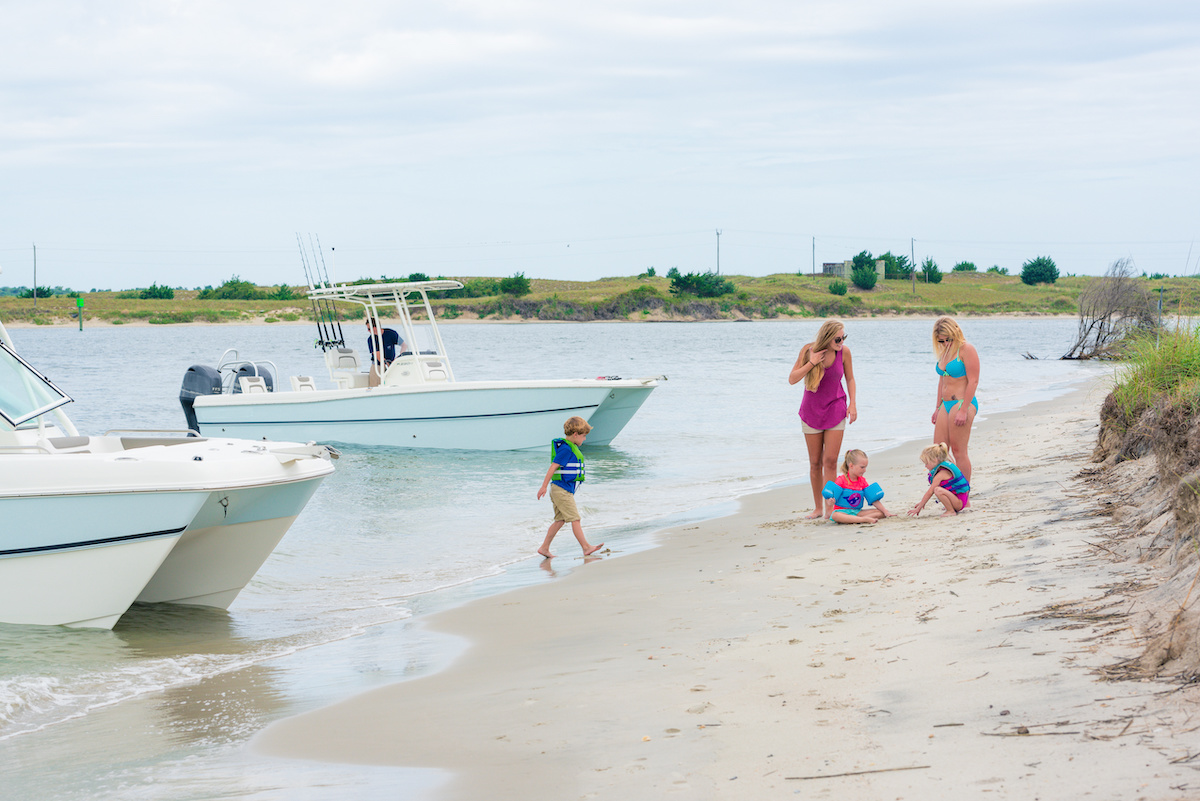
Let’s look at some of the types of catamarans and their best uses.
Sailing Catamarans
Sailing catamarans have made great strides over the past several decades. Small daysailing cats are popular because they provide a safe and simple learning platform and you’ll find fleets of them in resorts where they’re used by people with very little sailing experience. These types of small cats are usually made of roto-molded plastic or fiberglass and they typically don’t have auxiliary engines so their sole source of propulsion is sails.
Larger sailing cats have taken over the world of distance cruising and bareboat chartering . Nearly all tropically-based bareboat charter companies offer more sailing catamarans today than monohulls and those numbers are also growing in destinations such as the Mediterranean. Typically, charter cats have two engines, one in each hull, to maneuver as well as a mast that supports a mainsail and at least one headsail.
Explore Sailing Catamarans & Sailboats
Power Catamarans
Power catamarans, often referred to as "multi-hull powerboats" or "power cats," have larger engines than their sailing cousins and no masts or sails. Their bigger motors give them higher top speeds but these cats also need reinforced hulls to handle the weight and power of these engines. Other than pontoon boats (which arguably are also power cats), motorized cats are the fastest growing segment of the boating market.
Power cats come in various shapes and sizes. Numerous smaller power cat brands are marketed for fishing while larger ones are popping up in bareboat charter and as cruising platforms. Many commercial passenger ferries have also turned to the catamaran design for their spaciousness and speed.
Explore Power Catamarans
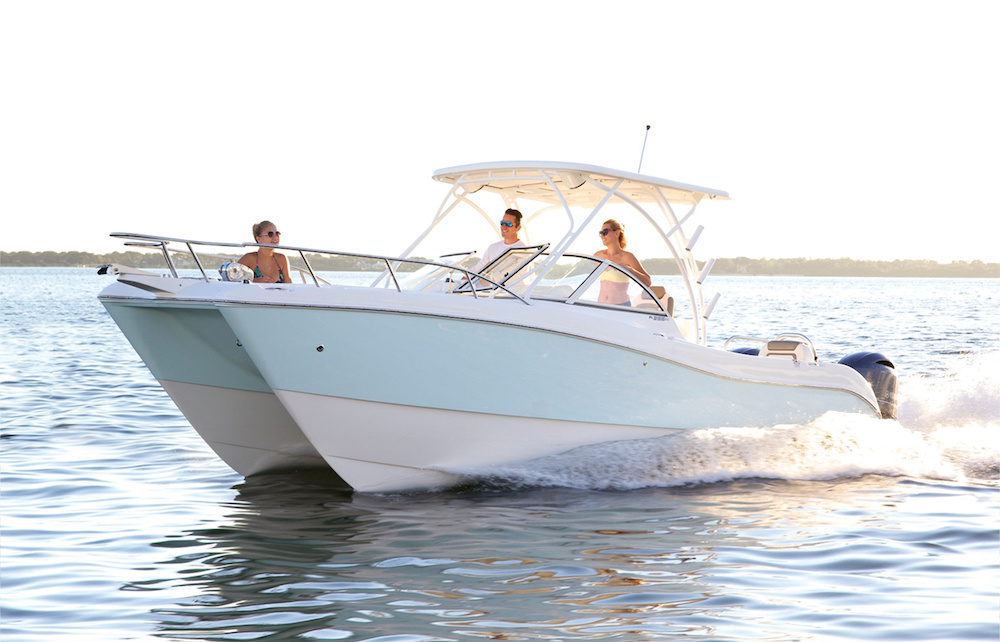
Advantages of Catamaran Boats
There are some inherent advantages of boats with multiple hulls, which include:
- More deck and interior space per foot than monohulls. A catamaran has about 1.2 times the space of a monohull. In other words, a 40-foot cat should have the deck and interior space of a 50-foot monohull. Cats also have more interior space with up to four cabins even in a vessel under 40 feet in length. These large cabins usually provide easier berth access and they have hull windows with opening ports for better ventilation and light even in the staterooms, which are usually more separated for privacy.
- Due to their design with two hulls set wide apart, cats enjoy greater stability under way and at rest in rolly anchorages . Unlike a monohull that can heel under sail or roll when powered, cats stay level, which makes them safer and easier for people and pets to maneuver on the flat deck. Some say cats have an easier motion than monohulls and tend to induce less seasickness.
- With twin engines, cats’ propellers are set wide apart so these boats have excellent maneuverability. Cats can venture into shallower waters too – especially sailing cats that don’t have deep keels. Because cats don’t drag a massive keel through the water, they’re also on average 20-30 percent more fuel-efficient even with two engines.
- Larger, more sophisticated power and sailing catamarans have a natural redundancy built into their equipment inventory, which translates to comfort and safety. For example, if a fresh water pump fails in one hull, there’s usually another to provide water for washing up. If one engine fails or one propeller spins off, there’s another to get the vessel to homeport safely. There’s also more room for the installation of additional systems like generators, watermakers, battery banks, and more.
Drawbacks of Catamaran Boats
Like any boat type, there are a few small drawbacks when it comes to catamarans:
- Catamarans take up more space so it’s often difficult and expensive to find dock space.
- Due to their design, both power and sailing cats can also slam the bridge deck into oncoming waves when going to weather.
- Additionally, sailing cats don’t necessarily sail as well upwind as monohulls because with two hulls, they simply can’t point as high into the wind.
- Finally, it may be tempting to load up a catamaran due to the space it offers but a sure way to damage a power or sailing cat’s performance is to overload them or have uneven weight distribution—something, which is less of a problem on their monohull counterparts.
Catamaran Boats FAQs
Whether used for daysailing, world cruising, chartering or fishing, boats with two hulls are growing in acceptance and appeal. The basic design may be hundreds of years old but today’s updated designs make catamarans a viable option for any boater.
Are catamarans more expensive than monohulls?
Purchasing or chartering a catamaran is usually more expensive than a monohull since there are more accessories and even more fiberglass construction to pay for. Over time, cost of ownership can be higher too since there are two hulls to polish and wax and more equipment to service or replace. It’s also more expensive to haul out a catamaran for bottom work.
What is the typical draft of a catamaran?
Draft (depth below waterline) depends on the size and type of cat. Small daysailing cats can draw mere inches but with a large cruising cat, it may be 3-4 feet. Some cats have dagger boards that are used to improve upwind performance. With the boards down, a cat can draw 10 feet or more but these boards may be lifted to allow access to shallow water.
Can catamarans be raced?
Catamarans make fine racers as has been proven by the America’s Cup contenders. There are also one-design classes in the smaller, open designs.
Read Next: Types of Sailboats, Activities & Uses
You Might Also Like:
- Boat Hull Types, Shapes & Designs
- Best Boats for Ocean & Offshore Boating
- Buying a Yacht: Motor Yacht Buyer's Guide
- Best Small Sailboats for Beginners
- Find the Right Boat for Your Lifestyle
Join Our Newsletter!
Get community news, buying bargains, and how-to guides at your fingertips.
What Is A Catamaran? Does It Have Engines Or Can It Only Sail?

Catamarans are a type of boat that has two hulls connected by a platform. They offer many advantages over traditional monohull boats, including increased stability and improved speed. This article will explore what exactly catamarans are and how they can be powered. We’ll also look at the differences between sailing and motor-powered catamarans to help you decide which one is right for you.
What Is A Catamaran?
A catamaran is a type of boat with two hulls connected by beams. It is usually powered by sails, although all modern catamarans come with inboard motors for propulsion. Catamarans are traditionally used for sailing, fishing, and leisure activities . They can be used in both fresh and salt water, and their light weight allows them to travel at high speeds without using much fuel.
Catamarans are known for their stability and durability due to their wide beam and shallow draft. This makes them ideal for traversing shallow waters or areas where the sea is choppy and unpredictable. They also have the advantage of being able to turn quickly and maneuver easily in tight spaces. Additionally, they provide a smooth ride despite rough seas since the two hulls help to reduce wave impact on the boat itself.
Advantages Of Catamarans
Catamarans offer many advantages to sailors and other seafaring travelers. The primary benefit of catamarans is their stability, due to the fact that they have two hulls that are connected by a platform. This design makes them much more resistant to waves than monohull vessels, which makes them ideal for activities such as fishing or leisurely cruises near shore. Catamarans also tend to be lighter, faster and more fuel efficient than monohulls, making them an attractive choice for sportier outings such as racing or overnight trips. In addition, catamarans can either be powered by engines or sails, giving you the flexibility to choose whatever type of propulsion suits your needs best.
Types Of Catamarans
Catamarans come in a variety of shapes and sizes, from luxurious yachts to fast-moving racing boats. They offer a unique sailing experience, with their twin hulls providing stability and comfort while still able to reach high speeds. Catamarans can be powered by engines or sail, enabling them to move swiftly through the water. Some are designed for serious racing, while others are equipped for leisurely cruising on the open waters. With so many options available, there is sure to be a catamaran that will fit any sailor’s needs. Whether it’s speed or comfort that you’re after, a catamaran can provide an unforgettable experience on the seas.
Sailing Vs. Motor-Powered Catamarans
Catamarans offer many advantages over monohulls and have become a popular choice for many reasons.. They are lightweight, stable, and provide ample space onboard. However, there is one major decision to make when purchasing a catamaran: whether to choose a sailing or motor-powered version.
Sailing catamarans have the traditional look of a boat with two hulls and tall sails, while motor-powered catamarans come equipped with engines and resemble more of a powerboat. Both types of catamarans offer their own unique benefits and drawbacks. Sailing versions are cheaper to purchase but require the sailor to be knowledgeable in sailing tactics in order to navigate easily. Motor-powered versions are more expensive but can be easier to operate in certain conditions due to their greater speed and maneuverability. In the end, it comes down to personal preference as both types can provide an enjoyable experience on the water.
Benefits Of Chartering A Catamaran
Catamarans are a type of sailing vessel with two hulls that are connected with a frame. They are typically very stable and have plenty of deck space for passengers and amenities. Catamarans also come equipped with two engines, so they can travel in calm waters even when there’s no wind to power the sails. The engine also allows them to get back quickly against strong winds or tides, making them great for long trips and passages.
The major benefit of chartering a catamaran is the amount of space it provides compared to traditional monohulls (a boat with one hull). This makes them ideal for larger groups, as they can accommodate more people without feeling cramped. Additionally, catamarans offer great stability in the water – even in choppy conditions – allowing you to feel safe and secure while onboard. Plus, since they don’t require as much maintenance as other boats, they’re perfect for longer periods of time on the water. All these factors make catamarans a great choice for any travel vacation with friends and family.
Frequently Asked Questions
Are catamarans suitable for excursions.
Catamarans are a popular choice for those looking to charter one for an excursion due to their spaciousness and stability. They provide more than enough room for comfortable traveling as well as plenty of storage space, making them an ideal option for extended cruising. Additionally, all catamarans are equipped with engines, allowing for easy navigation and maneuverability when needed. All in all, catamarans make great vessels for vacations and traveling and can be a great way to explore the waters.
What Is The Best Type Of Catamaran For Ocean Voyaging?
When it comes to ocean voyaging, the best type of catamaran is a modern performance cruiser. These vessels are designed to combine speed and comfort, with a shallow draft for navigating in and out of shallow waters. Modern performance cruising catamarans feature two hulls connected by an open deck, often with engines that give them greater maneuverability. They also generally have larger living spaces than traditional monohulls, so they can provide more comfortable accommodations during long voyages.
How Many People Can Typically Fit On A Catamaran?
A catamaran is a type of boat with two parallel hulls. Depending on the size, it can typically fit anywhere from 4-12 people plus crew. It’s important to note that the number of passengers will depend on the size and design of the boat, so it’s best to check with a manufacturer for more specific details.
A catamaran is a great choice for those looking to explore the ocean in style. They’re spacious and versatile, making them suitable for all sorts of travel plans and excursions. Plus, they can be powered by either engines and/or sails, so you can decide which works best for your needs. Charter prices can vary depending on your vacation needs. All in all, a catamaran is an excellent choice for anyone wanting to explore the open seas!
If you’re considering renting a catamaran, it’s important to do some research first. There are many different kinds to choose from depending on what your entire party has on their travel wish list – and make sure that you have a safe and fun voyage!
Get a Quote
Are you ready to let us show you what we can do for you? We can’t wait! This is as exciting for us as it is for you. We began this business because we love putting the perfect yacht charter together for our clients and getting the best of the best at the right price point thanks to our contacts and experience.
Use our quick contact form to give us the basics about what you’re looking for and we’ll send you ideas and pricing. Don’t worry if it’s not grand enough or should be scaled back; we’ll take care of that too. When you love the plan, we put it into action. All you have to do is show up and enjoy.
More Vacation Tips

Wellness on the Water: Rejuvenate Mind, Body, and Soul With Spa Experiences on Your Yacht Vacation
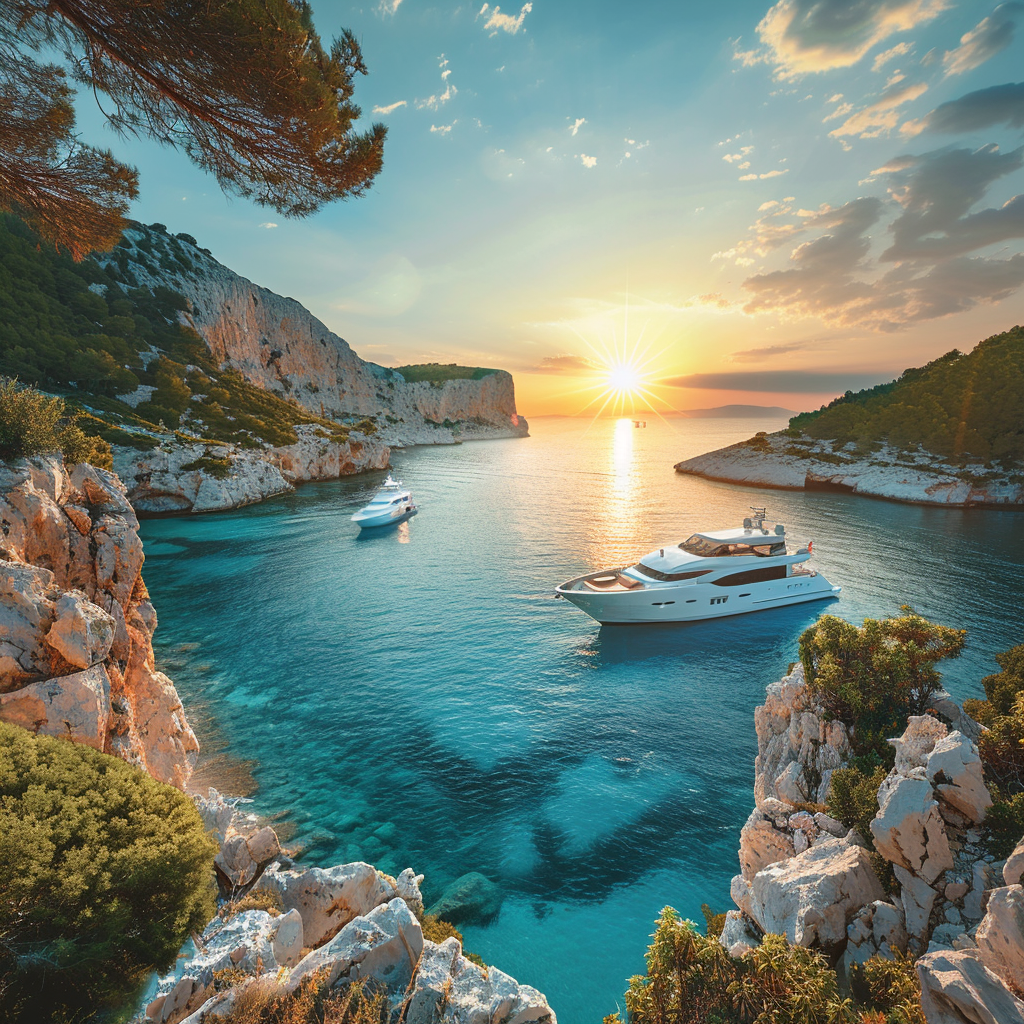
Secluded Serenity: Exploring the World’s Most Exclusive Coves on Your Caribbean Yacht Charter
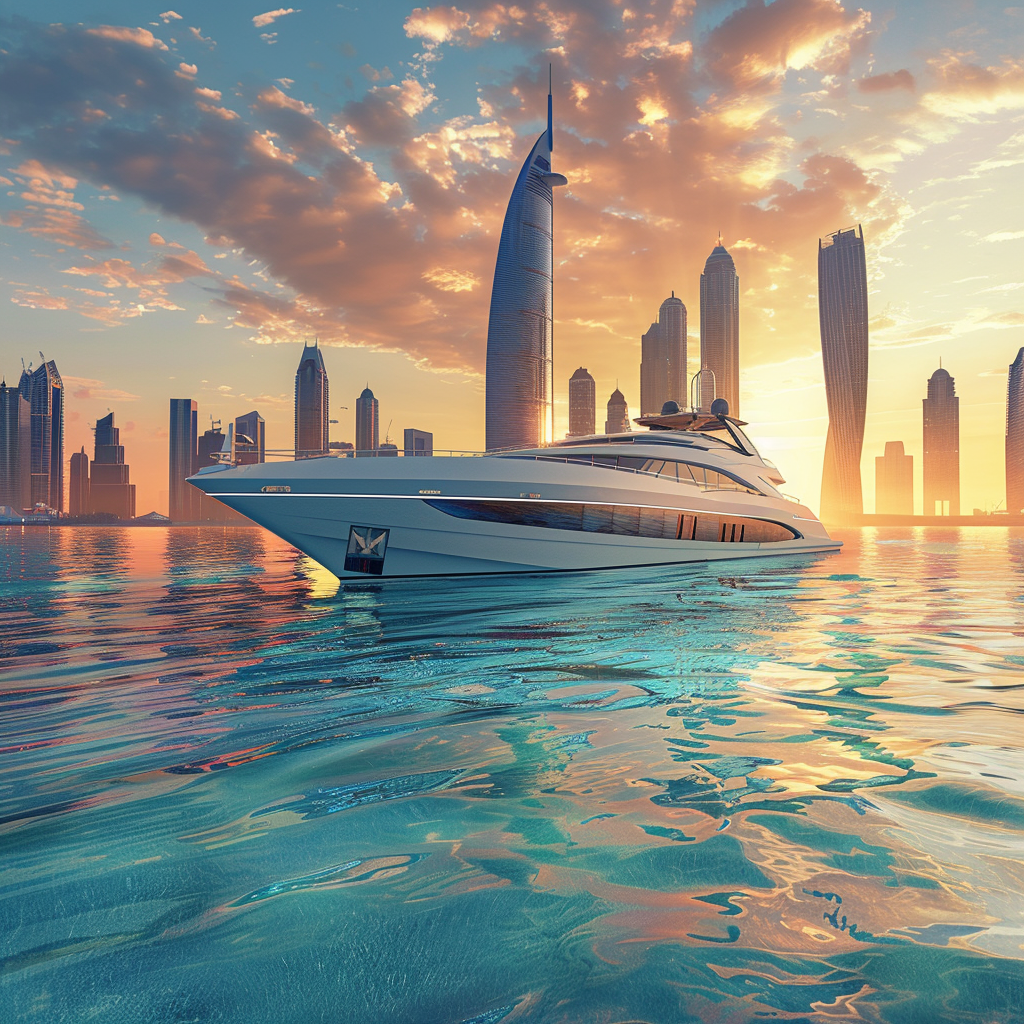
Sailing Into the Future: the Latest Technological Innovations in Luxury Yacht Rentals

Ultimate Guide to Cruising Catamaran Safety (Experts Advice)
As an Amazon Associate, we earn from qualifying purchases. We may also earn commissions if you purchase products from other retailers after clicking on a link from our site.
The catamaran’s popularity has steadily risen over the last 20 years, with many formerly devoted monohull owners switching over to a dual-hull system due to their speed and stability. Some say they’re closer to luxury apartments than sailboats! But are catamarans as sturdy as many of these converts say?
To sail a cruising catamaran safely, check the weather reports, learn about your boat’s safe sail limits, avoid high latitude sailing, and drift down to overboard victims. A catamaran cannot sink due to its positive buoyancy, although capsizing is mainly a myth, falling overboard is not.
In this article, I will give a bit of catamaran background information. Still, if you’re interested in really understanding how a catamaran works and how it differs from a monohull, I recommend you read this article . Today l will address what the experts say on “the best safety practices for catamaran sailing”.
If you are interested in understanding why a catamaran capsizes, read this article!
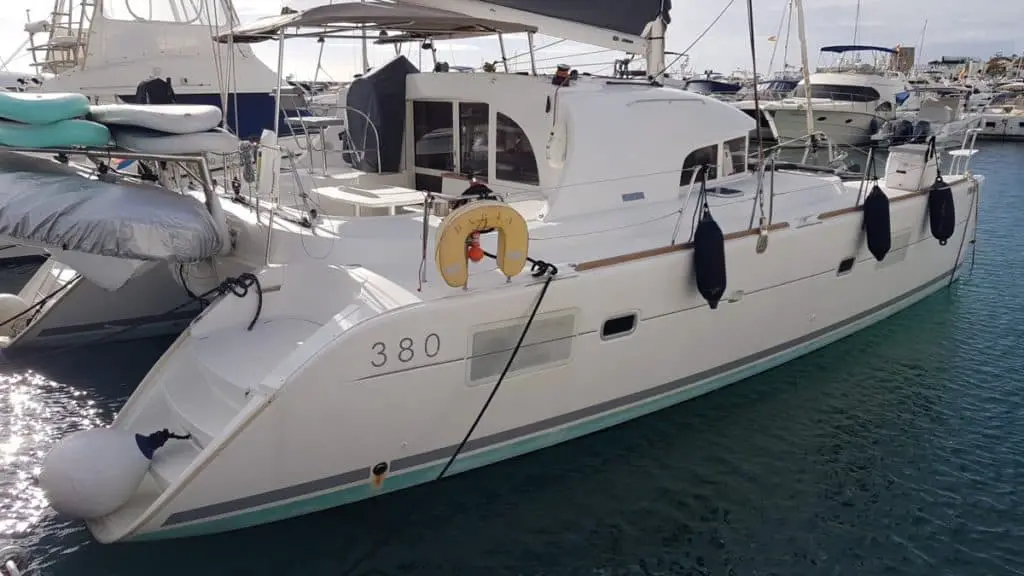
Table of Contents
What Exactly Is a Catamaran?
The name ‘catamaran’ actually derives from the Tamil word kattamuram , which means “logs bound together.” The Tamil word applies to the rafts popular throughout Southern India and Sri Lanka, more rustic sailing vessels, typically made of three to seven tree trunks tied together.
In English, the word was adapted to refer to a double-hulled boat or a double-bodied vessel. The presence of two hulls and a wide, central beam allows for better balance and stabilization in the water than the heavily ballasted keels that are part and parcel of most monohull boats.
Do you want to better understand what a Catamaran is? Read my other article!
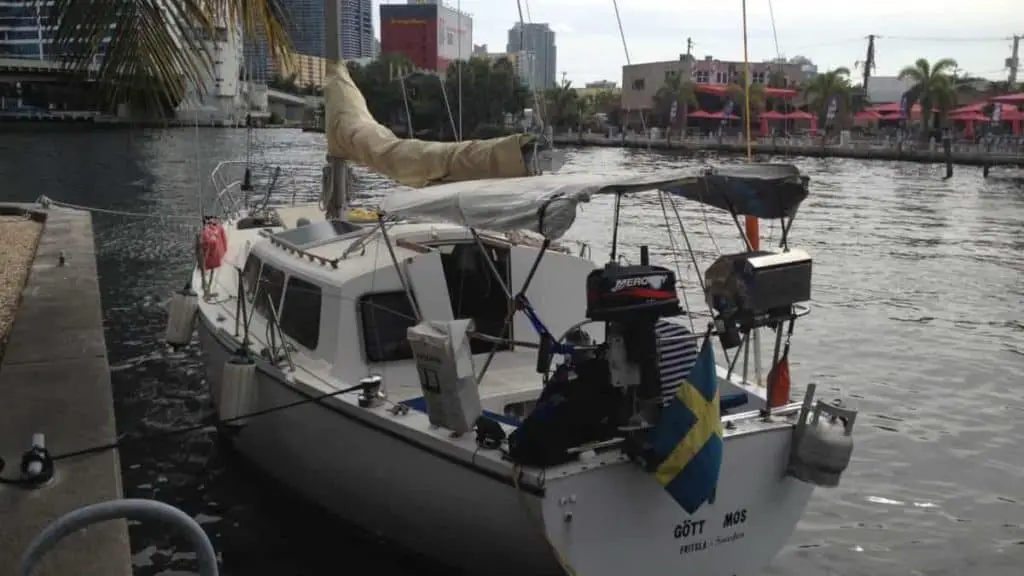
Catamarans vs. Monohulls: Advantages & Disadvantages
Catamarans have experienced a rise in popularity over the last 20 years, well-liked for their size, stability, and effective luxury. Let’s go through and discuss the benefits and tradeoffs of catamarans in several different categories.
There are tons of differences between sailing a mono and a cat, here is the (almost) complete list!
Safety Advantages of a Cruising Catamaran’s Design and Layout
There are significant differences between monohulls and catamarans in terms of their size and architectural design and between the various effects these two factors will have on the security of your individual marine experience. Let’s highlight the most glaring physical differences between the two and how that factors into your individual safety aboard a catamaran.
Due to their dual hull configuration and buoyancy, catamarans are very resistant to capsize. While a monohull has the potential to sink when capsized, catamarans are essentially stable waterborne vessels that have a natural buoyancy, rendering them literally unsinkable. Catamarans’ positive buoyancy ensures that even in the event of a capsize or fractured hull, they’ll remain afloat no matter what.
Moving around the deck (whether at anchor or during travel) is significantly less risky on a catamaran’s stable platform. There is no need to fret about your drink spilling or items getting knocked over, thanks to the level and stable surface offered aboard a catamaran.
We’ll discuss the best ways to stay safe aboard a capsized cat later on in the article.
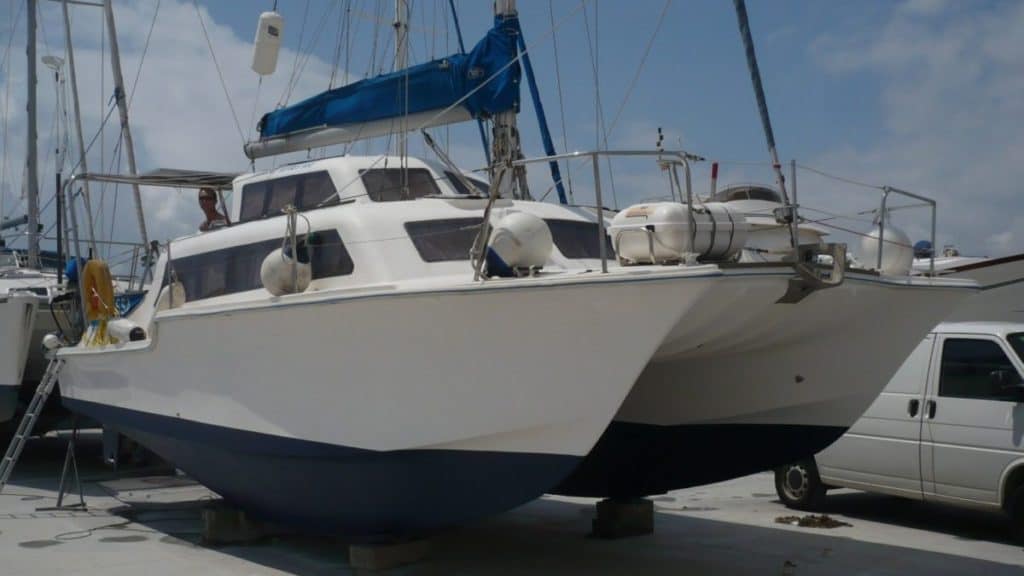
Cruising catamarans have two of almost everything—two hulls and two engines, which negates a bow thruster’s necessity. Having two of everything—including engines—makes engine issues less dire than behind the helm of a monohull.
One of a catamaran’s major benefits is that you always have a backup available, which comes in handy in any situation. In the words of the Catamaran Guru , “The second engine can still move the boat, create electricity, and charge batteries, so no problem.”
The stability aboard a two-hulled vessel “ensure[s] that your crew will not expend unnecessary energy to simply try and stay upright, says Catamaran Guru . “Your crew on a catamaran will be well-rested and alert and will be able to function well if a stressful situation arises.”
They Don’t Roll Easily
Catamarans have a much wider base than monohull boats, so strong wind and waves won’t tilt the vessel nearly as much. Their wide, low-profile design limits their roll inertia, as explained by Sail Magazine. This trait is beneficial near rocky shores, sneaker waves, or out in the open water. Those looking for safety paired with luxury should choose a catamaran for these reasons.
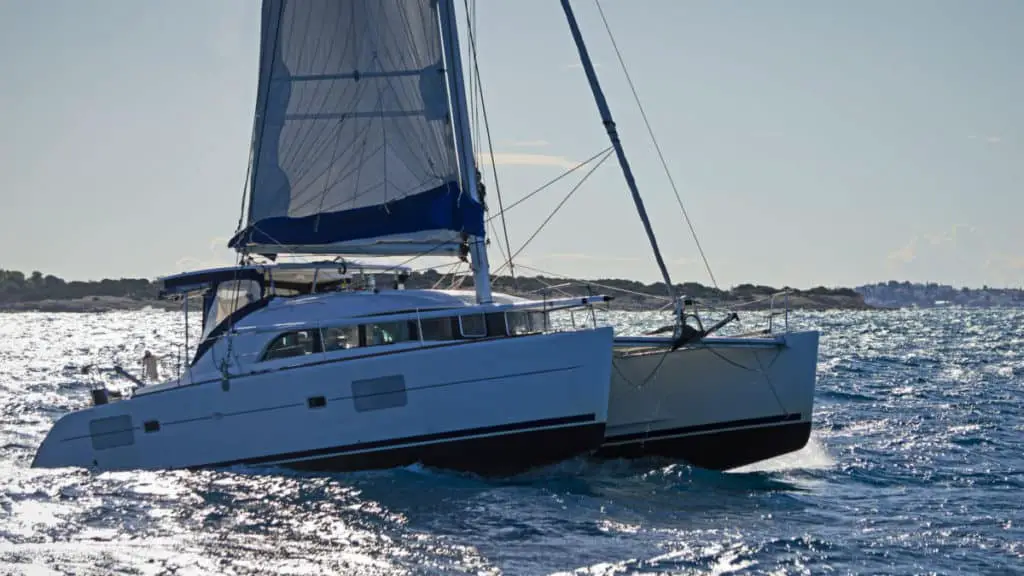
Cruising Catamaran Advantages in Terms of Safety
Cruising catamarans are unsinkable.
As discussed above, cruising catamarans have positive buoyancy; even in the event of a capsize or fractured hull, unlike a monohull, a catamaran will never sink. We’ll discuss the best ways to stay safe aboard a capsized cat later on in the article.
Little to No Heeling Aboard
Cruising catamarans don’t heel more than 10-12 degrees, even at full speed. On account of their equal weight-bearing, they don’t roll at anchor either. Whether the wind is acting up or you’re navigating choppy waters, a catamaran will remain pretty stable with little to no rocking or swaying.
Less Chance of Falling Overboard
Not only can heeling cause seasickness and discomfort, but it can also be very dangerous. Changing the sail and reefing is much safer on a catamaran than on a monohull.
“Without the rolling and pitching motion, the danger of falling overboard on a catamaran is considerably less than on a monohull,” Catamaran Guru .
Fewer Chances of Crew Fatigue and Sea Sickness
Crew fatigue is a genuine threat when sailing the open seas, and a catamaran does a good job of mitigating this problem. Seasickness can be caused by various factors, including anxiety, physical fatigue, lack of sleep, and inability to maintain homeostasis. The stress from this routine and lack of sleep can often be attributed to the caprice of the waves.
All of these factors serve to disorient and wear out crew members, which in turn can lead to poor decision-making and potentially fatal errors in seamanship. Without the added stress of struggling to remain independently upright, the crew will benefit from a reserve of focus and energy that one might not see in a more erratic vessel.
Basic operations like sail changes and reefing are easier and less dangerous on a stable vessel, diminishing the risk of serious injuries and chances of falling overboard. In the words of Catamaran Guru ;
“Fresh and alert crew contributes to a much safer vessel.”
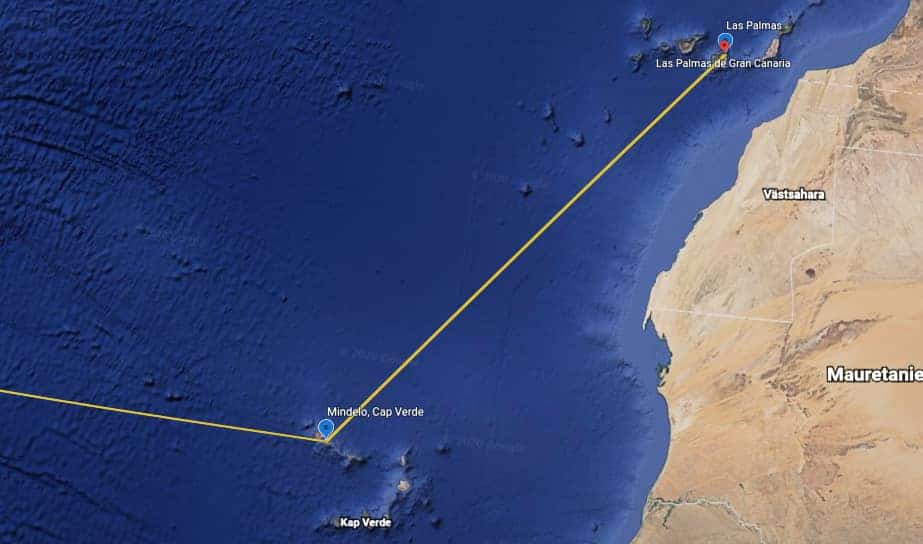
Cat’s Heightened Speed Can Help Outrun or Avoid Bad Weather
The lightness of the cruising catamaran’s form and locomotive power of its dual-engine system makes it faster by comparison than most monohulls. Not only is this ideal in terms of a speedy and efficient means of travel, but it can also prove useful when trying to outrun bad weather.
Some catamarans can have a 220 mile/day (354.06 km/day) cruising capacity. With appropriate forewarning via marine forecasting technology, a cruising catamaran can outrun or at least assist in chartering the boat to a more favored position in avoiding inclement weather.
Cruising Catamaran Safety Disadvantages
Although many are converting from the monohull lifestyle to devoted cat owners, there are still a few areas in which a monohull may be preferable.
- Cramped hulls: Though many more recent models have roomier hull space, the narrow hulls of many catamarans can feel a little claustrophobic. David Parkinson of Yachts International compares the experience to being “like living in a tube” and argues that communicating with individuals in the opposite hull might prove difficult if an emergency arises.
- It’s better for experienced sailors: On account of their somewhat cumbersome nature, in inclement weather, it’s helpful to have a more experienced crew. Although catamarans are quite stable in nature, there is always the possibility of capsizing. As discussed, a catamaran will never sink, but catamarans do not have the same ‘self-righting’ aptitude possible in monohulls.
Catamaran Safety Issues and How To Deal With Them
Capsizing and falling overboard are the two foremost issues that crew worry about while sailing a catamaran. Here, we’ll discuss how to avoid these situations and what to do should they arise:
The number one safety concern of most potential catamaran owners is fear of capsizing.
When do catamarans actually capsize? forget the myths, read my scientific explanation.
According to Catamaran Guru , many sailors in the cat community hold that the concept of capsizing is almost mythological in nature.
“Modern cruising catamaran design has critical design criteria that safeguards against this very thing. They are designed with a low center of gravity and a safe power-to-weight ratio to ensure that it is virtually impossible to lift a hull, regardless of the conditions.”
According to Nick O’Kelly—a former meteorologist turned full-time catamaran captain—fear of capsizing is one of the last things most catamaran sailors think about in terms of potential danger on the open sea. You can watch his video here:
Many experienced seamen argue that whatever would capsize a catamaran would do the same to a monohull. Oddly enough, being struck by lightning is more likely, as catamarans statistically tend to attract lightning more so than their single-hulled counterparts.
Here’s how to avoid capsizing:
Stay Informed Regarding Weather Conditions
According to record-breaking multihull sailor Brian Thomson, the worst thing to face on a catamaran is a sudden increase in wind. Always be prepared to reduce sail early when you see a storm. Normally you can see a storm rolling in during the day, and at night it will show up on the radar, though most ships always reef at night anyway.
“I think watching the weather, really understanding what’s happening with the weather…it affects how you sail day and night,”
Thomson elaborates.
“The more information you have on the weather, the easier it is to decide on your sail plan.”
Understanding Your Boat
Try to understand better your boat’s unique composition and the elements that make it waterborne. According to Sail Magazine, you should make an honest evaluation of your boat’s attendant strengths and limitations before taking it out.
“The boat’s manufacturer should also give you a sail-selection chart specifying safe sail limits for any conditions, If no such guide exists, a simple heeling gauge may be helpful.” Sail Magazine
According to Nigel Irens, a leading yacht designer, it’s important to understand exactly how your boat will sit on the water when upside-down; he notes that most experienced sailors will use this practice with a dinghy, though it’s significantly harder with larger vessels. “There are ways of evaluating through calculations where [your boat] will float, or pretty much exactly,” he notes in this video from Yachting World Magazine :
It’s a much more complicated process than one might think, and oftentimes these estimations are based on a virtual model. “I think it’s fundamental before you consider what you’re going to do in the very unlikely event of a capsize, the first thing is you absolutely have to know what level the boat’s going to float,” observes Irens. “So that’s the first thing, and up to us technicians really.”
Once this is estimated, the rescue and survival gear inside the boat should be located in a way that makes it accessible if the boat gets flipped over.
If you want to understand how to prepare your boat for a capsize, I would definitely recommend reading the book Multihull Seamanship by Gavin Le Sueur . The drawings are a little bit lame, but the information is beneficial, and the book costs around 15$ on amazon.
Assess Your Route
Sail Magazine asserts that the sea room should be the first thing considered in terms of deciding trip logistics. “Are you in open water and able to sail around the conditions? Or are you sailing along a coast with limited room to leeward?” These are the types of questions that owners need to ask themselves before departure.
“On most offshore passages, advanced communications and weather information should preclude you from ever experiencing true gale or survival conditions,” observes Sail Magazine.
They note that the riskiest times of year to sail are between seasons, particularly when on a North-South route.
“Early spring or late autumn passages between New England and the Caribbean, in eastern Atlantic waters off Europe, or on routes between the South Pacific and New Zealand are where you typically have a chance of experiencing a good wallop offshore.” Sail Magazine also encourages following the advice offered in Jimmy Cornell’s World Cruising Routes , which should lower your risks of running into inclement weather.
You’ll need to understand what direction to sail and your vessel’s capabilities—whether sailing windward or leeward will be to your best advantage.
Avoid High Latitude Sailing
It’s not recommended to take your catamaran to high latitude ports. High-latitude locations tend to be the domain of monohulls, as there are very few metal catamarans out there. There also tend to be many “deadheads” in these waters, which can damage your boat.
But why sail to the cold and nasty when you can enjoy crystal clear warm waters!
What To Do in the Event of a Capsize
In the event of a capsize, it’s best to seek refuge in the hulls. Your boat is watertight when it’s right-side-up, so naturally, it will be airtight the wrong-way up. Irens advises against rushing to open the emergency exits right away; if air rushes in or rushes from out of the hull and is replaced by water, obviously, the boat will float lower.
Brian Thomson advocates that you’d want to head to the parts of the boat that are normally lower as if the boat flips over, they will become the highest points.
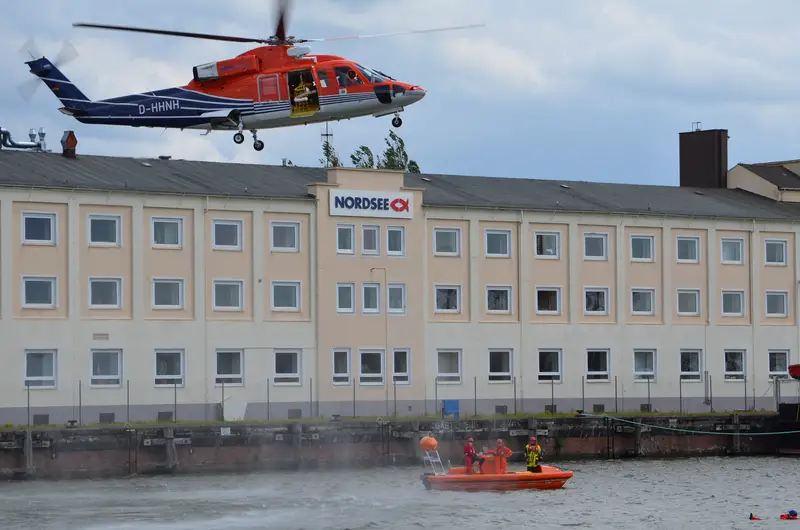
Avoid Man Overboard
Having someone fall overboard is a problem most crews are far more likely to face than capsizing. The most important thing to keep in mind during a rescue mission is that you don’t want to further injure the victim, especially by hitting them with a hull or an unfortunate scrape with the propeller.
Cruising the Caribbean, we would routinely practice man overboard (MOB) drills;
The one rule about MOB is that you should do everything you can to avoid it.
This might seem obvious, but try it out a few times, and I dont mean on a beautiful calm day. Try it on a little windier day with some swells, and you’ll quickly understand why a MOB situation will be life-threatening once the weather gets a little nastier. Keep your crew on or inside the boat!
What To Do in the Event of Man Overboard
Nigel Irens recommends that it’s best to “drift down onto the [victim],” so you don’t lose contact with them. As there’s not one but two propellers just beneath the surface, you wanted to make sure they aren’t pushed beneath the boat where their legs might be in danger.
Irens says that the victim should be on the windward side, and the boat should come in downwind from them—perhaps turning a slightly upwind—before gently drifting towards them.
Brian Thomson recommends motoring back and coming up gently to the person, with someone on deck at the ready to pull them onboard—via a life sling, harness, or even a chair.
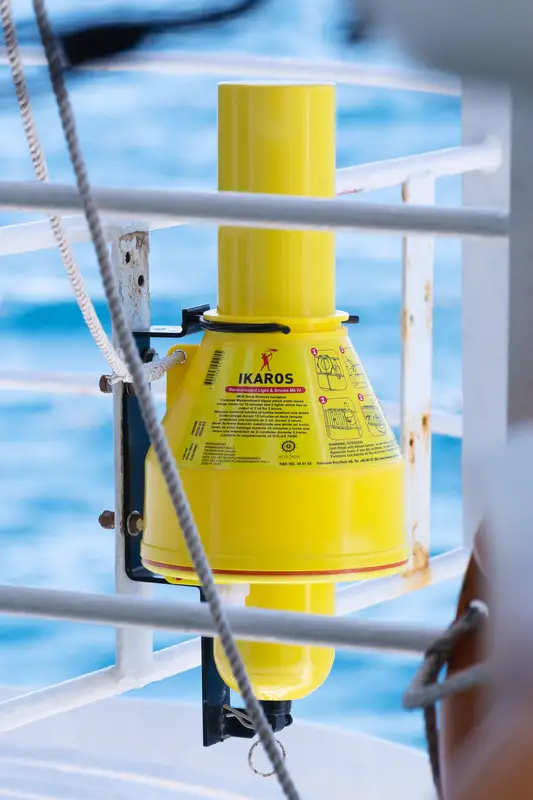
Offshore Catamaran Sailing Is Best Left to Experienced Sailors
In the end, experience is the most important factor in determining the crew’s safety, and what seems to matter most is the skills of the crew running the boat. The American Sailing Association notes that when switching over from a monohull,
“the entire sailing experience is different; the motion of the boat is different, you have to trim the sails differently, and pay attention to other factors that you might not be used to.”
In sailing (and life), one should prepare for the worst. Catamaran’s stability, buoyancy, and redundancy are some of their best features, but even these safety features don’t balance out a lack of sailing knowledge and experience.
Cruising Catamarans are very safe on account of their stability and buoyancy. While fears of capsizing are mostly unfounded, staying on top of the weather forecast, understanding your boat, and mapping out your route beforehand are the best ways to avoid any sort of issues.
If someone falls overboard, it’s best to gently let the vessel drift towards the victim with a life raft or other rescue device on hand. Following the above advice will help you relax and enjoy the comfort, space, and quality sailing experience of your cruising catamaran.
Owner of CatamaranFreedom.com. A minimalist that has lived in a caravan in Sweden, 35ft Monohull in the Bahamas, and right now in his self-built Van. He just started the next adventure, to circumnavigate the world on a Catamaran!
Leave a Reply Cancel reply
Your email address will not be published. Required fields are marked *
Save my name and email in this browser for the next time I comment.
Recent Posts
Must-Have Boat Gear for Catamaran Sailors!
Sailing is probably the most gear-intensive activity I've ever done; there are so many decisions to be made about what gear to buy now, for tomorrow, and what to definitely never buy. The gear on...
6 Best Trailerable Trimarans For Bluewater and Coastal Sailing
Having a boat costs a lot of money, even when you are not using it, marina fees, etc. And once it is in the water most sailors never go very far from their "home marina" and sailing will be somewhat...
- Go to content
- Go to footer

- Rental operators
- Service centers
- Pre-owned Lagoon catamarans
- The Lagoon Premium Program
- Finance your Lagoon
Club Lagoon
choose your language

Your dream destination
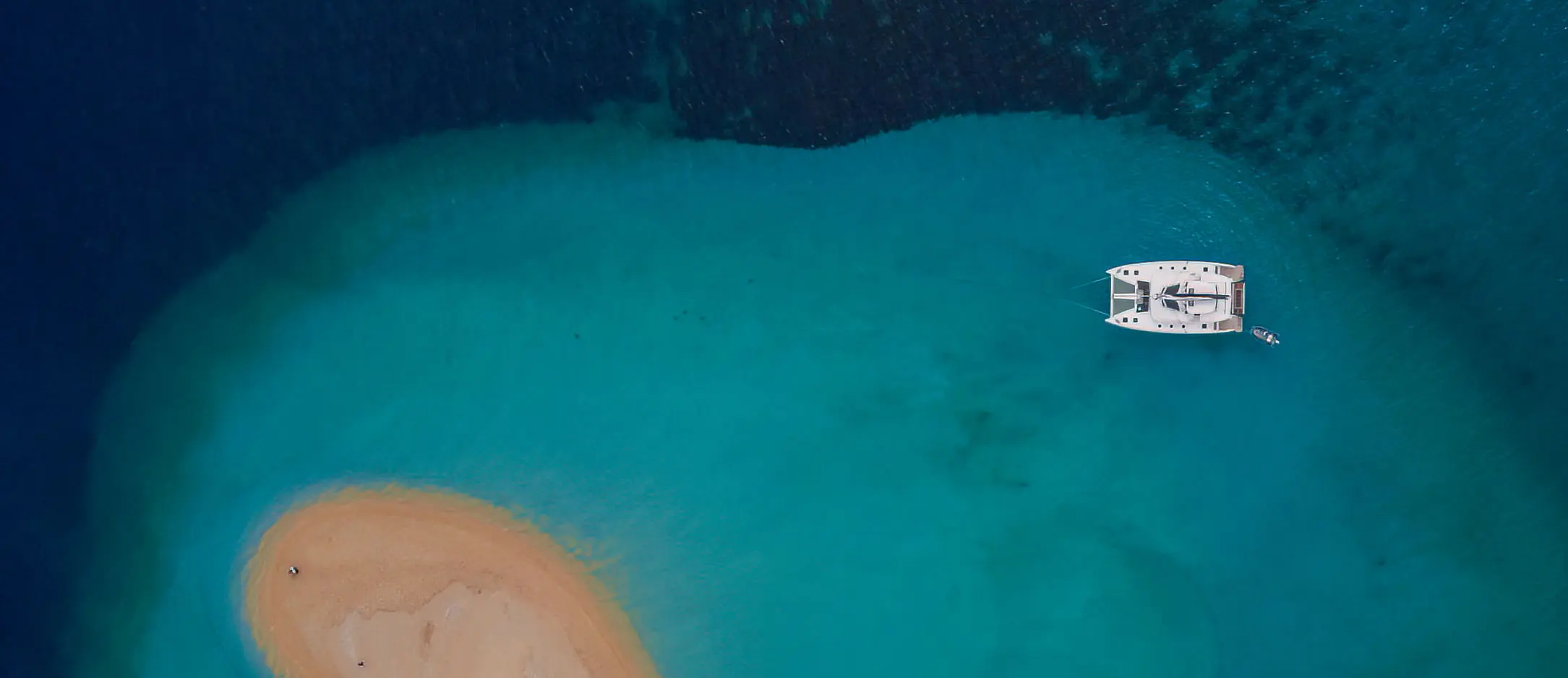
Lagoon celebrates its 40th anniversary with you!
In 2024, Lagoon wants to celebrate its 40th anniversary with you. Throughout the year, there are numerous events waiting to be discovered.
Catamarans to live your dreams
At Lagoon, we do everything we can to make your sailing to the ends of the earth as enjoyable as possible, but when it comes to choosing your model, it's up to you!

YOUR DREAM DESTINATION
At Lagoon, we infuse our love of the sea and our admiration for nature into the construction of our boats. For you, we always aim for excellence.
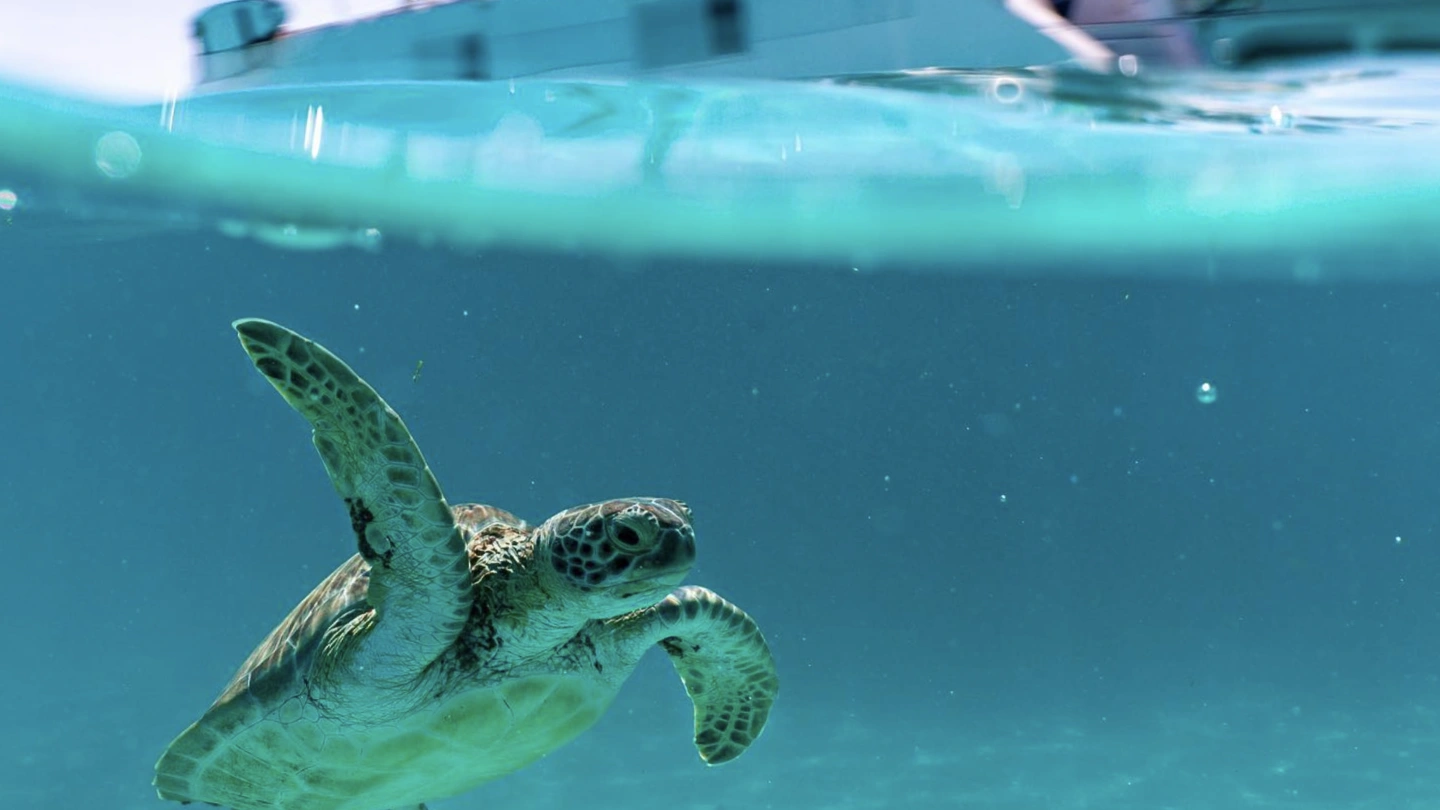
Lagoon's sustainable commitments
Lagoon's history is intimately linked to its marine environment and we are committed to preserving it every day. Over the last few years, we have taken a major step forward in terms of sustainability.

The Club Lagoon
Are you a Lagoon catamaran owner, or do you dream of becoming one? Our club is for you. By joining, you'll benefit from exclusive offers and privileged access to our partner marinas around the world.
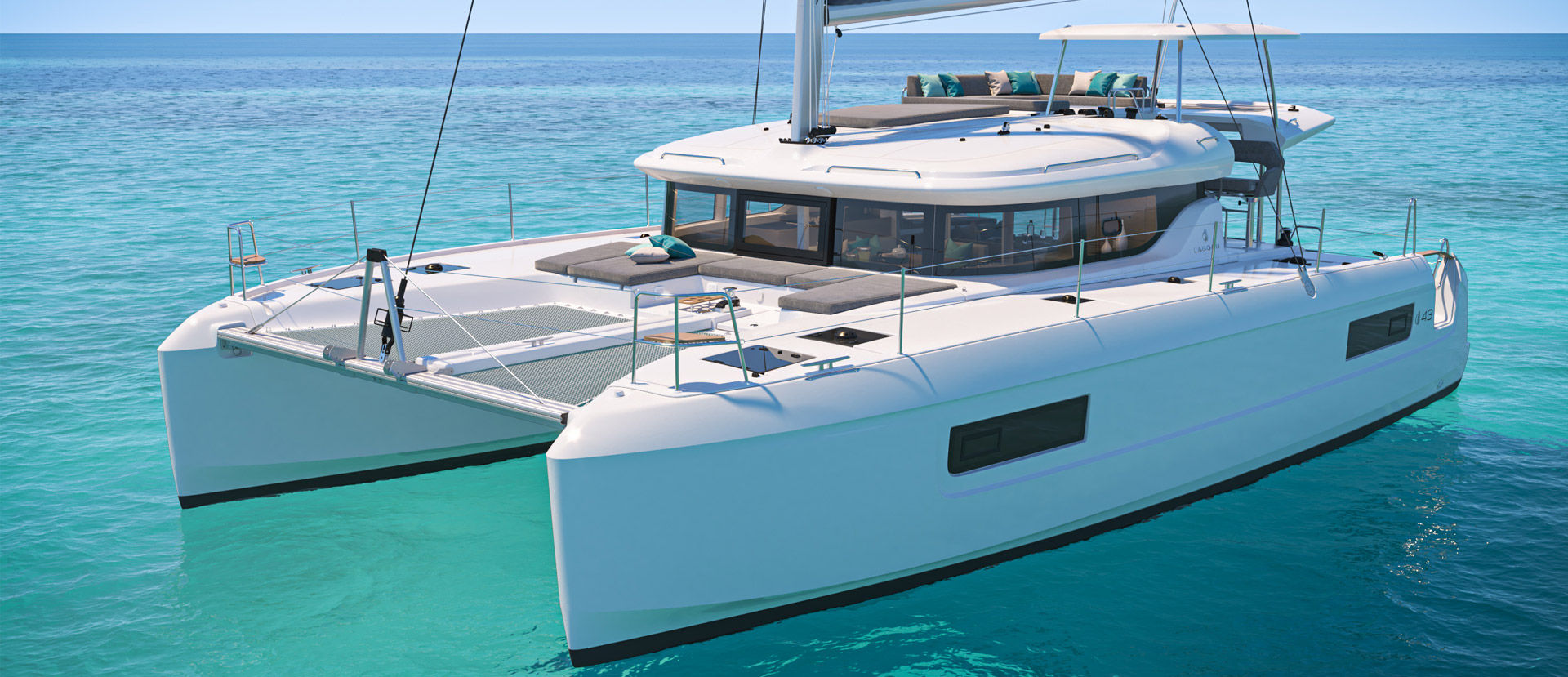
Generous, enjoyable, convenient, featuring ease of movement, this brand new Lagoon 43 is definitely adaptable by nature!
Continue your navigation
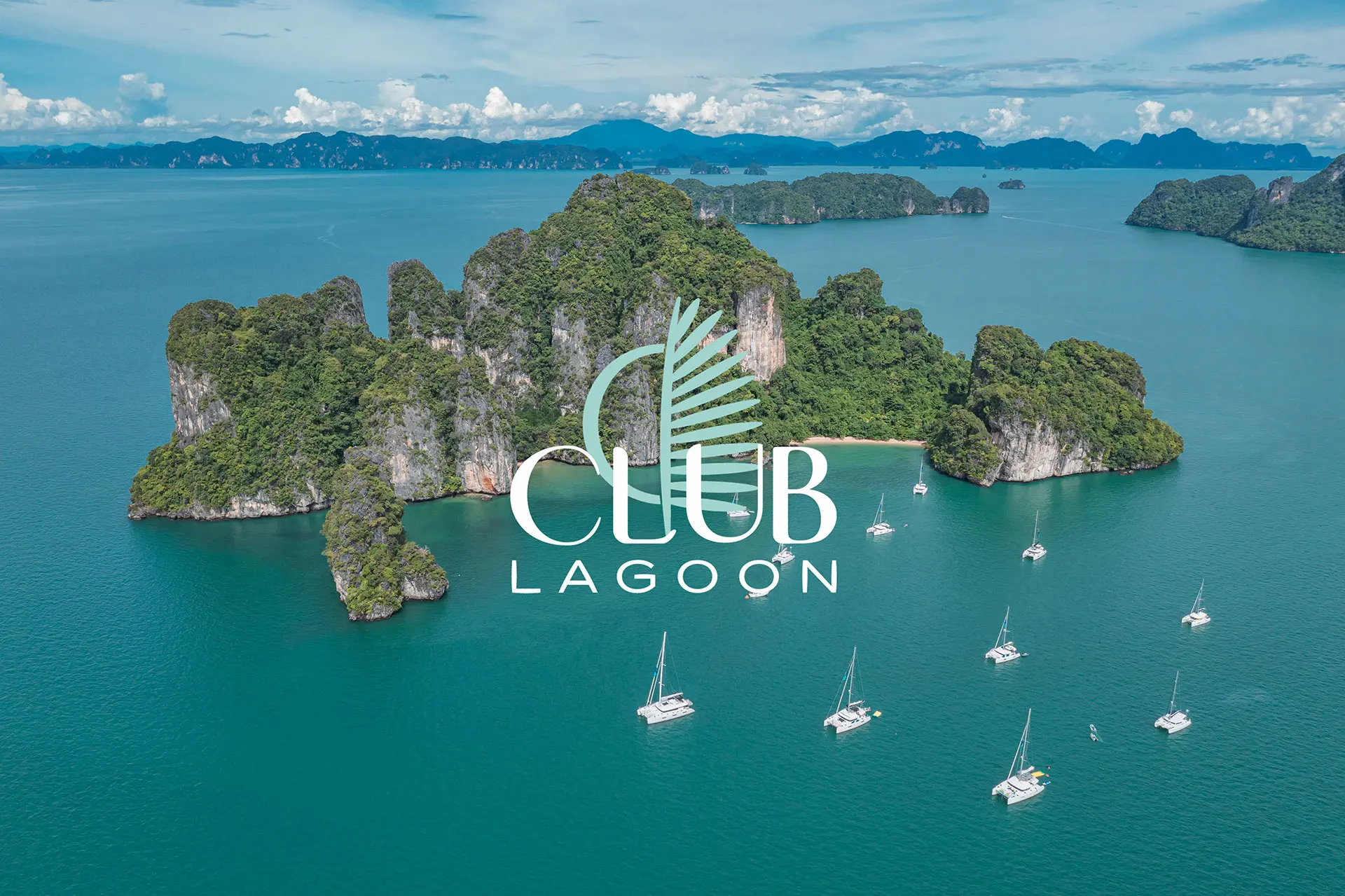
Our Partners
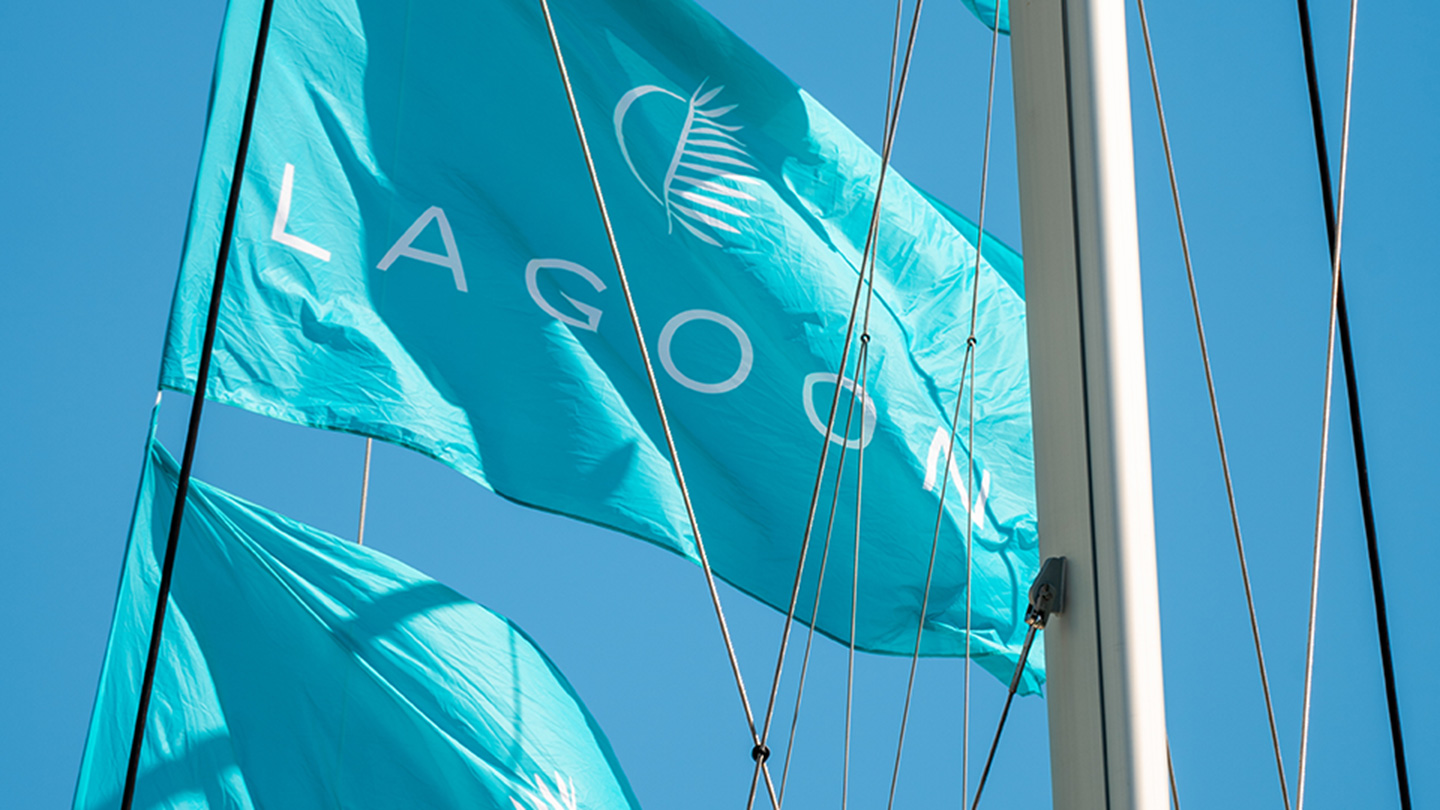
Owners' testimonials
Lange family and “spirit of ponta preta”.
There was a time when my whole being turned into a trance as soon as the leaves were moving in the trees, as I was thinking about the potential windsurf session that I was missing.
PRESS REVIEW

What Is A Catamaran?
Everything you need to know about catamarans before you set sail!
As the summer season approaches, California is gearing up for an influx of visitors from all over the world. Most tourists flock to San Diego for its laid back vibe and gorgeous beaches.
Not just that, but most visitors also love this city because of the sheer variety of things you can do there. You can go fishing, kayaking, snorkelling, swimming, tanning, and catamaran sailing in just one trip to San Diego.
But most people don’t know what catamaran sailing is before visiting America’s Finest City. There’s no need to worry, though. This article will tell you all there is to know about catamaran sailing.
If you hear someone mention a cat while talking about sailing, they’re most probably referring to a catamaran! A catamaran is a yacht or a boat with two hulls parallel to each other.
It has a broad base that is supported by the two equally spaced hulls and is a lot more stable than a monohull boat. Most people usually use them for recreational purposes such as going on a cruise or a fishing expedition.
You shouldn’t confuse a catamaran with a trimaran, though. A catamaran has two hulls, while a trimaran has three. Cats also face a lot less resistance because of their twin hulls so they can cut through the water more easily.
Because of that, they need less propulsive power to move as compared to a monohull of a similar size. Catamarans can be of any size, from small sailing ones to huge ones that people use to ferry cars.
Catamarans are more stable than monohulls because the two widely-spaced hulls balance the weight of the vessel in such a way that the water doesn’t make it bob from side to side too easily. It also allows the manufacturers to give the boat a broad base, making the catamaran spacious and comfortable.
These vessels can also hold more weight than a monohull of comparable size, which means you can rent a catamaran to spend time with a large group of people, such as your family or friends.
Why You Should Rent A Catamaran
The waters of San Diego are perfect for renting a catamaran. The fresh breeze, the California sun, and the lively waters make sailing a catamaran a lot of fun there. All you need to do is find a reliable catamaran rental company to get a perfect catamaran for your holiday.
There are several reasons why you should rent a catamaran. Let’s talk about them.
Increased Stability
If you or anyone in your travel group is scared of sailing, a catamaran might be just the thing for them. Its twin hulls allow the catamaran to sail smoothly so that the people sitting in it don’t feel a thing. It’s ideal for people who want the sailing experience with the scary bobbing and swaying.
A catamaran has a lot more space than a traditional monohull or a speedboat. Hence, you can take a large group of people with you to maximise your enjoyment. The more, the merrier!
Generally, the two hulls join together to form a large stable platform that has around four cabins; one in each corner. Most San Diego yacht rental companies use the central space as a seating or dining area. You can also just lounge there to look at the spectacular views passing you by.
Less Seasickness
Some people love to go out on the sea but don’t do it often because sailing on nearly any kind of vessel makes them seasick. The way most monohulls have rocky movements on the sea induce vomiting and nausea in a lot of people, making them unable to enjoy the trip.
A great solution to this problem is renting a catamaran. A catamaran doesn’t move from side to side while sailing the way all other boats do. Since it has a hull on each side, the weight o the vessel is equally distributed, causing it to stay stable while sailing.
This characteristic induces less seasickness in susceptible people, so if you’re one of them, contact our San Diego yacht rental company today for a smooth ride on oour catamaran yacht.
Skipper Availability
If you don’t know how to sail a catamaran, don’t worry! Triton Charters offer skippers to help you on your trip, allowing you to have an uninterrupted, thrilling time with your family and friends.
Reach out to us today to book your private rental, or sign up for one of our lower priced ticketed cruises. At just $55 per adult, its a cost effective way to enjoy the luxury of a catamaran on a budget!
If you fall in love with sailing after taking a ride on our catamaran, you can check out this resource for a list of boater safety courses to get on the path to becoming a California boat license holder.
Increased Safety
Catamarans have increased safety as the manufacturers install two engines in them. In the event that one fails, the other will do its job just fine, allowing you to have a safe and uneventful journey. In addition, the increased stability of the catamaran will enable you to feel minimal disturbances in case your yacht encounters a storm or rough waters.
Whether you want to have a relaxed holiday with your family or a fun-filled holiday with your friends, you can’t go wrong with a Catamaran. Luckily, we offer excellent packages for the upcoming season, so don’t forget to enjoy the San Diego coastline with a catamaran trip. Give us a call today to book your adventure!
To learn even more about renting a yacht in San Diego, please visit our articles page!
- HELP ME TO CHOOSE THE PERFECT BOAT!
- +44 20 3769 3987
More results...
- Mediterranean
Indian-ocean
- Atlantic Europe
Pacific-ocean
- Catamaran charter
- Motor yacht charter
- Sailboat charter
- Gulet charter
- Luxury yacht charter
- 12 person boat rental
- 20 person boat rental
- 60 ft yacht charter
- Last-minute yacht charter
- Early booking yacht charter
- Bareboat yacht charter
- Crewed yacht charter
- Cabin yacht charter
- Flotilla sailing
- Easy sailing destinations
- Experienced sailing destinations
- Culture sailing destinations
- Family sailing holidays
- Honeymoon yacht charter
- Types of yachts
- Boat rental services
- Sailing routes, tours, trips, itineraries
"The best solution for your real time boat rental from experts you can trust!"
Types of catamarans
Destinations
- 7 14 21 28 1 2 3 4 5 6 7 8 9 10 11 12 13 14 15 16 17 18 19 20 21 22 23 24 25 26 27 28 29 30 31 32 33 34 35 36 37 38 39 40 41 42 43 44 45 46 47 48 49 50 51 52 53 54 55 56 57 58 59 60 nights
Please select Sailing yacht Catamaran Motor yacht Motor boat Gulet Rubber boat (R.I.B.) Mini Cruiser Jet Ski
Home » Types of yachts » Types of catamarans
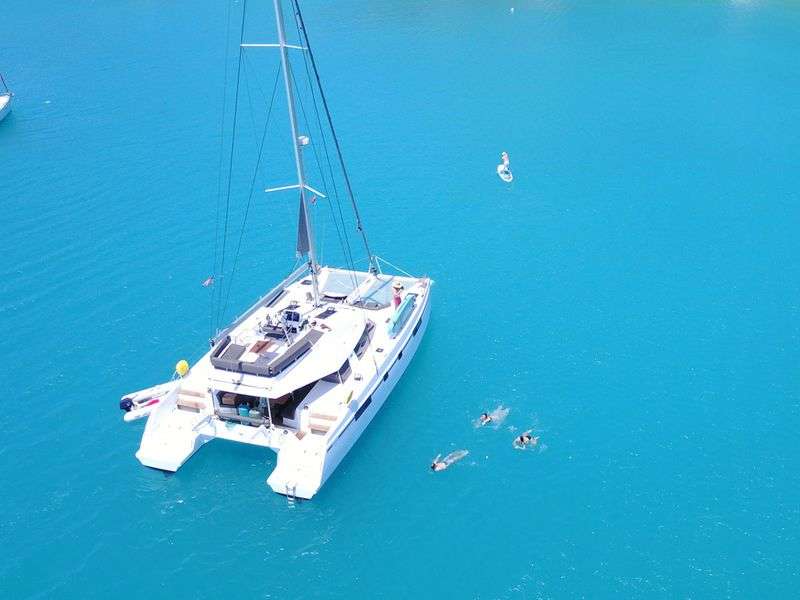
This article will introduce the following:
The origins of the catamaran
Why is a catamaran a good choice, types of catamarans: catamarans may be categorized as follows, before you start…, how to rent a catamaran.
Catamarans were first built-in the 17th century by a fishing society called the Paravas in Tamil Nadu on the Northern shores of India. At first, the idea of two hulls was objected to by yacht manufacturers who had been used to models that have a single hull. Still, catamarans proved to have the best design amongst rapid vessels. This was due to their great stability and capacity. The main feature of these boats was the two-hulled design, which provided for more effective balance compared to other vessels of the era. The idea was first adopted by the British, and later it became widespread in the whole world. Evolution not only resulted in a change in relation to use but influenced and developed the designing and construction of boats to a great extent.
Types of catamarans: Design of catamarans
We distinguish between two types of catamarans in terms of design: the so-called Pontoon and the SWATH (Small Waterplane Area Twin Hull). The former is a small and compact boat that applies a floating technique in order to drive the two hulls. The latter is a large vessel which uses a method based on preserving the balance of the boat. They are ideal for areas where erratic waves are common. These larger types may be categorized as yachts. Today, a wide selection of catamarans are available, for instance, the motorized types, which are even more reliable.
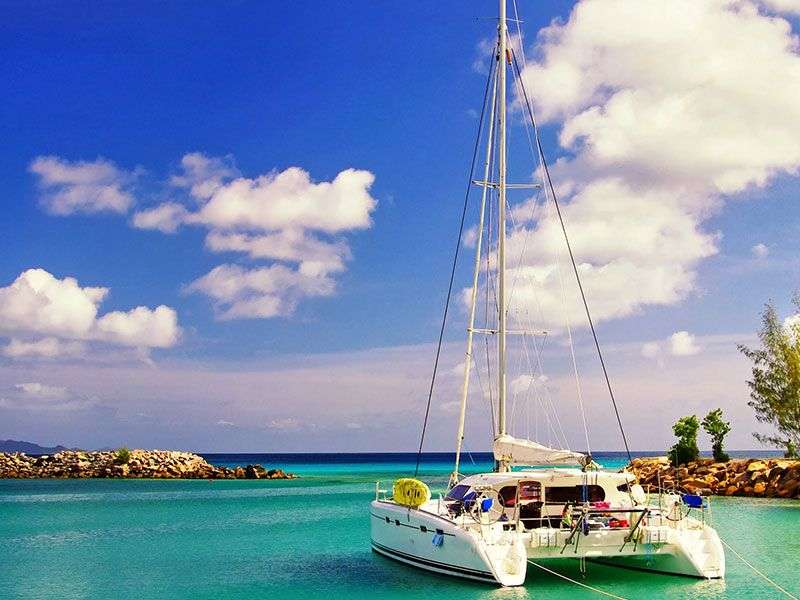
Catamarans are available in several designs and sizes. Their size may vary, from 14 ft (4.5 m) to 100 ft (30.5 m) long models. Catamarans include sea cruisers with a weather deck, boats with cabins, etc. Besides the two hulls, they have a mast and, depending on the size, one or two sails. It may be a surprising fact that catamarans are considered standard yachts rather than sailboats.
Cruise catamarans
These boats are referred to as luxury catamarans or catamaran ferries. They provide the best service and luxury for passengers. The additional motors make these boats even more attractive for people. Having a shorter journey time, these ferries are ideal for passengers who want to spend more time in a city’s port. It must be noted, however, that luxurious catamarans only function within the country and not internationally. Catamaran cruisers offer all the best features of motor yachts. The Stena Voyager on the Irish Sea and the American Victoria Clipper IV are two of the most popular cruisers.
Sailing catamarans

Choose a route and get to know the destination better before leaving the port! Read the guides, search for information about a route or contact the charter agency which will provide you with recommended routes in a graphical form. When choosing a route, take into consideration the duration of your rental, and plan your programs accordingly! We recommend cruising for 3–6 hours a day while taking into account the fuel consumption that depends on the weather, and the size and type of the boat.
Boat rental is not as complicated as it first seems, especially if you have a good agent. There are always some basic questions arising during the rental process. The service provider can help you plan your cruising adventure. We have collected all the necessary information to make the process easier for you.
- First, you have to decide what type of boat you would like to rent. Certain models of catamarans are ideal for the whole family. This kind of journey can be a real adventure for the kids; a great example of active recreation.
- The number of people and the requirements for their comfort, the services provided on the deck and the need for a staff should all be considered.
- Make sure that you understood all the conditions and have received all the necessary information, including the duration, type and price of your rental.

Safety first!
Sibenik - Croatia
wir durften vom 19.06. bis zum 26.06.2021 zum zweiten Mal einen wunderschönen Urlaub auf einer BoatTheGlobe-Yacht genießen.Mit dem wunderschönen Bali...
Anna und Günter (Austria)
Caorle - Italy
Amazing Luigi was a fantastic host, accessing all areas of the yacht. The deck was comfortable with lots of space to relax and sunbathe and drink in the amazing...
Sebastian (Belgium)
Ibiza - Spain
Very Impressed with the quality of service. We had a small malfunction of one of the yachts that we had on our charter and they repaired it right away. They truly went...
Mike (South Africa)
HELP ME TO CHOOSE THE PERFECT BOAT
Need to find the right boat with the help of an expert send us your needs and we will find the most suitable yacht for you we offer only boat rentals, 1-day cruises not.
- press the right mouse button on the e-mail received from us
- select the following from the options: Add sender to list of safe senders.
More information on our privacy policy and personal data protection .
BoatTheGlobe
"The best solution for your real time boat rental from experts you can trust!"
- Indian Ocean
- Pacific Ocean
- Sailing in … Sailing intineraries, ports, coasts & islands
Not to be missed!
Subscribe to our newsletter to be the first to know about discounted boat rental options!
- Motorcycles
- Car of the Month
- Destinations
- Men’s Fashion
- Watch Collector
- Art & Collectibles
- Vacation Homes
- Celebrity Homes
- New Construction
- Home Design
- Electronics
- Fine Dining
- Costa Palmas
- L’Atelier
- Les Marquables de Martell
- Reynolds Lake Oconee
- Scott Dunn Travel
- Wilson Audio
- 672 Wine Club
- Sports & Leisure
- Health & Wellness
- Best of the Best
- The Ultimate Gift Guide
This New 79-Foot Sailing Catamaran Is Like a Pied-à-Terre for the High Seas
The six-stateroom "spirit of ponant" will debut in corsica this summer., rachel cormack.
Digital Editor
Rachel Cormack's Most Recent Stories
- A Treasure Trove of Princess Diana’s Dresses, Shoes, and Accessories Is Heading to Auction
- ‘It Feels Cooler’: Gisele Bündchen Believes in the Power of a Big Watch
This Luxe 157-Foot Catamaran Lets You Explore the Galápagos With a Personal Butler
- Share This Article

Ponant is returning to its roots in small-ship cruising.
Related Stories
- Chevy’s New Corvette Could Be Its Most Powerful Yet
- One of Jay Leno’s Favorite Ferrari Mechanics Was Just Arrested for Theft and Fraud
- 20 Fascinating Facts About the Iconic Ferrari F40

Based on Lagoon’s Seventy 7 model, the newcomer was built in Bordeaux, France. The cat features six generous staterooms for up to 12 guests and cabins for four crew. Ponant says seafarers can expect personalized service, including a private chef, tailored activities, and other high-end touches.
“The concept and design of this Lagoon Seventy 7 yacht has been praised by everyone in the industry, won over by the spacious interior and exterior areas,” Guillaume Le Brec, the experienced skipper in charge of this project at Ponant, said in a statement. “Guests will really appreciate the high-end finishings as much as her exceptional sailing qualities.”
Furthermore, the itineraries are completely customizable, too. The inaugural seven-night roundtrip voyages from Bonifacio can be tweaked to the traveler’s interests, with the captain offering recommendations. After a stint in Corsica, Spirit of Ponant will cruise around Mahé, a.k.a. the largest island in the Seychelles archipelago, for the winter season.
Rachel Cormack is a digital editor at Robb Report. She cut her teeth writing for HuffPost, Concrete Playground, and several other online publications in Australia, before moving to New York at the…
Read More On:
- Cruises/Yacht Charter
More Marine

You Can Now Play Padel Ball on the Deck of Your Superyacht

This New 239-Foot Megayacht Concept Pairs Sleek, Minimalist Design With Over-the-Top Luxury

Numarine Just Delivered 3 New Explorer Yachts at Once

Culinary Masters 2024
MAY 17 - 19 Join us for extraordinary meals from the nation’s brightest culinary minds.
Give the Gift of Luxury
Latest Galleries in Marine

Hermes Catamaran in Photos

Day One Superyacht in Photos
More from our brands, for isabel marant, boho never stopped being in style, american flag football league delays men’s pro launch to 2025, digging into the cannes lineup, sight unseen: heavy on english movies and light on women, photography curator pleads not guilty to child pornography charges and attempted enticement of a minor, the best swim goggles for men, according to competitive swimmers.
Posted 2024-04-10 19:55
Contact Information:
2024 Wavewalk S4 Mcroskiff - $3,000

more ads by this user
QR Code Link to This Post
post id: 7736060366
posted: 2024-04-10 19:55
♥ best of [ ? ]
refresh the page.
2024 Wavewalk S4 Mcroskiff - boats - by dealer - marine sale -...
2024 Wavewalk S4 Catamaran Cartop Microskiff For full S4 info see here: https://wavewalk.com/blog/boat-skiff/ The S4 is a patented, ultralight twin-hull boat. It is portable, maintenance-free,...

IMAGES
VIDEO
COMMENTS
A catamaran ( / ˌkætəməˈræn /) (informally, a "cat") is a watercraft with two parallel hulls of equal size. The distance between a catamaran's hulls imparts resistance to rolling and overturning. Catamarans typically have less hull volume, smaller displacement, and shallower draft (draught) than monohulls of comparable length.
A catamaran is a twin-hull boat with two equally-sized hulls placed side by side. They're powered by engines, sails, or both—and they're known for efficiency and speed. Catamarans are the most common kind of multihull boat. In this article, we'll go over the characteristics of catamarans and how to differentiate them from other types of ...
A catamaran offers flat, even decks, wide, safe passages, and no climbing when having to move from bow to stern. Tips for Sailing a Catamaran. With its large area exposed to wind and its low draft, a sailing catamaran can drift off easily so anchoring should be performed as swiftly as possible, especially if the wind blows from the side.
A catamaran is a design for a boat that utilizes two hulls. Due to the flat, platform-like-potential for the deck of the boat, the catamaran is often purposed with transporting materials, vehicles, and people. For instance, catamarans are quite often used as ferries.
Understanding the Basics of a Catamaran. Understanding the basics of a catamaran is essential for safe and enjoyable sailing. A catamaran is a boat with two parallel hulls connected by a deck. It has advantages over monohull boats. Catamarans are stable due to their wide beam, reducing the risk of capsizing.They can access shallow waters because of their shallow drafts.
catamaran, twin-hulled sailing and powered boat developed for sport and recreation in the second half of the 20th century. Its design is based on a raft of two logs bridged by planks that had earlier been used by peoples in the Indonesian archipelago and throughout Polynesia and Micronesia. Early catamarans were up to 21.3 metres (70 feet) long, originally paddled by many men, and used for ...
Activities: Overnight Cruising, Racing, Fishing, Day Sailing, Liveaboards. Length Range: 25 - 160 ft. Average price: $607,000. 2-12 cabins. Whether you're shopping for a new fishing boat, a sailing cruiser, or anything in-between, you'll come across catamarans.
Beach catamarans are also commonly referred to as 'beachcats.'. Getting wet is part of the fun when sailing on a beachcat, and these boats are known for their fast speeds and athletic sailing abilities. They can reach 20 knots, can be beached on the sand, and then re-launched through the surf.
Generally, brand new sailing catamarans and power catamarans will have a price tag in the range of $200,000 to over $1 million. Whereas used catamarans on the brokerage market can be found for around $500,000 and under. Of course, these are general guidelines and will depend on the age of the catamaran, the length of the boat, and the condition ...
This makes docking your catamaran a breeze compared to single-hulled sailboats. Travelling on the sails. Sailing varies mainly in what courses you can sail and how strong the winds are. Most charter catamarans perform best on courses at 50 to 60 degrees to the wind. This is a greater angle compared to sailboats.
A Catamaran is a sail or engine-powered boat with a double hull, a distinct feature that makes it immediately recognizable once you're aware of the design. People often question whether a catamaran is a yacht, and due to the sleek style, versatility, speed capabilities, and comfort, a catamaran definitely earns the yacht stamp of approval.
The cockpit contains navigation and steering equipment and is from where the sails, rudder, and engine are controlled. Deck; is the top part (roof) of a catamaran covering the hulls and bridge deck. The deck is made hard enough to walk on. To the deck, attaches lifelines and other equipment.
A catamaran is a boat with two hulls and a bridge between them. Catamarans can be designed as sailboats or motorboats. A catamaran stays stable since it has a wide base, it does not have a deep keel as on a monohull. Cats are known for not heeling, increased comfort, more space, and faster speeds. In this article, we will explore everything you ...
Available from 20 to 48 feet, catamarans typically offer a large fishing platform with generous storage and fishing amenities. They are available in a wide variety of deck layouts, including center-consoles, dual-consoles, and even pilothouse and express variants. Cats offer abundant deck space. Courtesy Invincible.
Here are some key points to consider about sails and rigging: 1. Sail design: The design of the sails, including their size, shape, and material, plays a significant role in the catamaran's performance. High-performance racing catamarans often have larger, more efficient sails that generate greater speed. 2.
Understanding the Basics of a Catamaran. A catamaran is a boat with two parallel hulls connected by a bridge. Understanding the basics of a catamaran is important to fully enjoy the unique sailing experience it offers. These hulls provide stability and reduce drag, enabling higher speeds. Catamarans are used for sailing, cruising, and racing.. The design allows for a spacious interior layout ...
Advantages of Catamaran Boats. There are some inherent advantages of boats with multiple hulls, which include: More deck and interior space per foot than monohulls. A catamaran has about 1.2 times the space of a monohull. In other words, a 40-foot cat should have the deck and interior space of a 50-foot monohull.
Types Of Catamarans. Catamarans come in a variety of shapes and sizes, from luxurious yachts to fast-moving racing boats. They offer a unique sailing experience, with their twin hulls providing stability and comfort while still able to reach high speeds. Catamarans can be powered by engines or sail, enabling them to move swiftly through the water.
To sail a cruising catamaran safely, check the weather reports, learn about your boat's safe sail limits, avoid high latitude sailing, and drift down to overboard victims. A catamaran cannot sink due to its positive buoyancy, although capsizing is mainly a myth, falling overboard is not. In this article, I will give a bit of catamaran ...
19/10/2022 Learn more. "Lagoon, the number one cruising catamaran worldwide, is a brand of the Groupe Beneteau. While it is undeniable that this heritage has led to its current rank as leader, the first models were built by its competitor at the time, Jeanneau. Let's take a look back at the genesis of Lagoon."
A catamaran is a yacht or a boat with two hulls parallel to each other. It has a broad base that is supported by the two equally spaced hulls and is a lot more stable than a monohull boat. Most people usually use them for recreational purposes such as going on a cruise or a fishing expedition. You shouldn't confuse a catamaran with a trimaran ...
Leopard 42. Built by Robertson & Caine and designed by naval architects Simonis Voogd, the Leopard 42 utilizes superior finishes and materials, creating a one-of-a-kind vessel that balances comfort, performance and ease of handling. A thoughtful design process ensures every feature and function has been anticipated, with minimal customization ...
Types of catamarans: Catamarans may be categorized as follows. Catamarans are available in several designs and sizes. Their size may vary, from 14 ft (4.5 m) to 100 ft (30.5 m) long models. Catamarans include sea cruisers with a weather deck, boats with cabins, etc. Besides the two hulls, they have a mast and, depending on the size, one or two ...
The six-stateroom "Spirit of Ponant" will debut in Corsica this summer. Ponant is returning to its roots in small-ship cruising. The French cruise line just added a new 79-foot sailing catamaran ...
2024 Wavewalk S4 Mcroskiff. -. $3,000. The S4 is a patented, ultralight twin-hull boat. It is portable, maintenance-free, extremely stable, and seaworthy. The S4 is molded from High Density Polyethylene (HDPE), a resilient and durable polymer resin from which kayaks are made. Wavewalk also produces the W720 Kayak-Skiff.